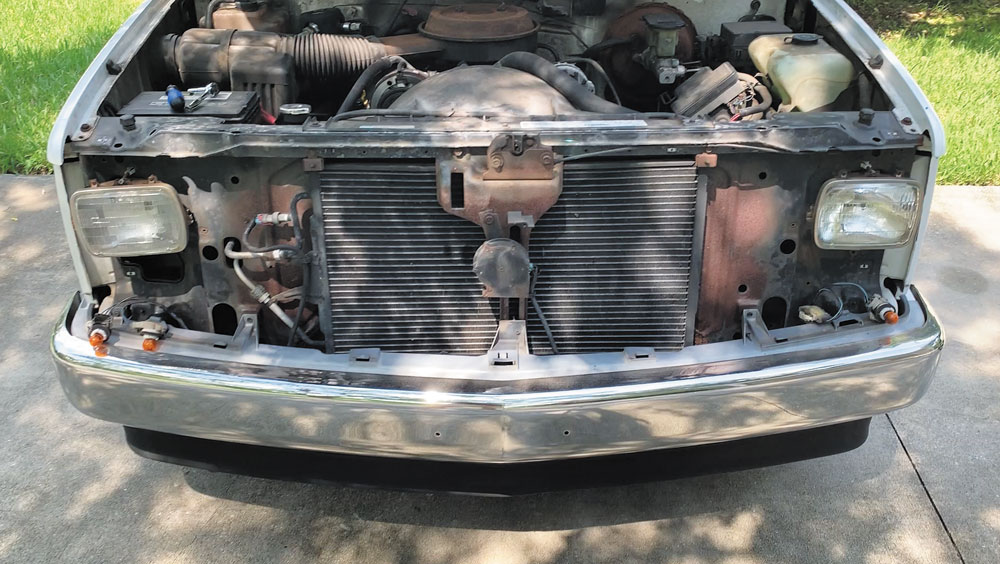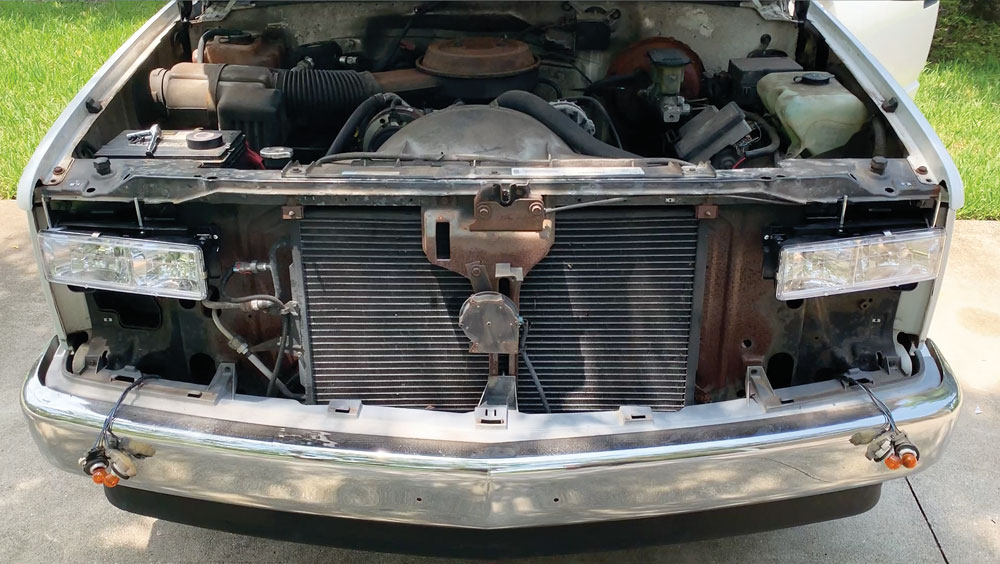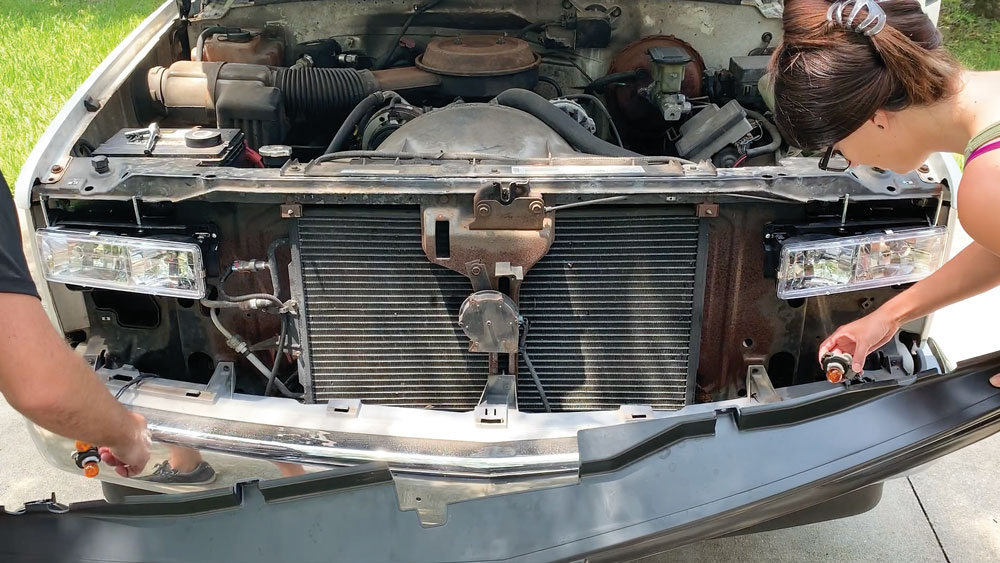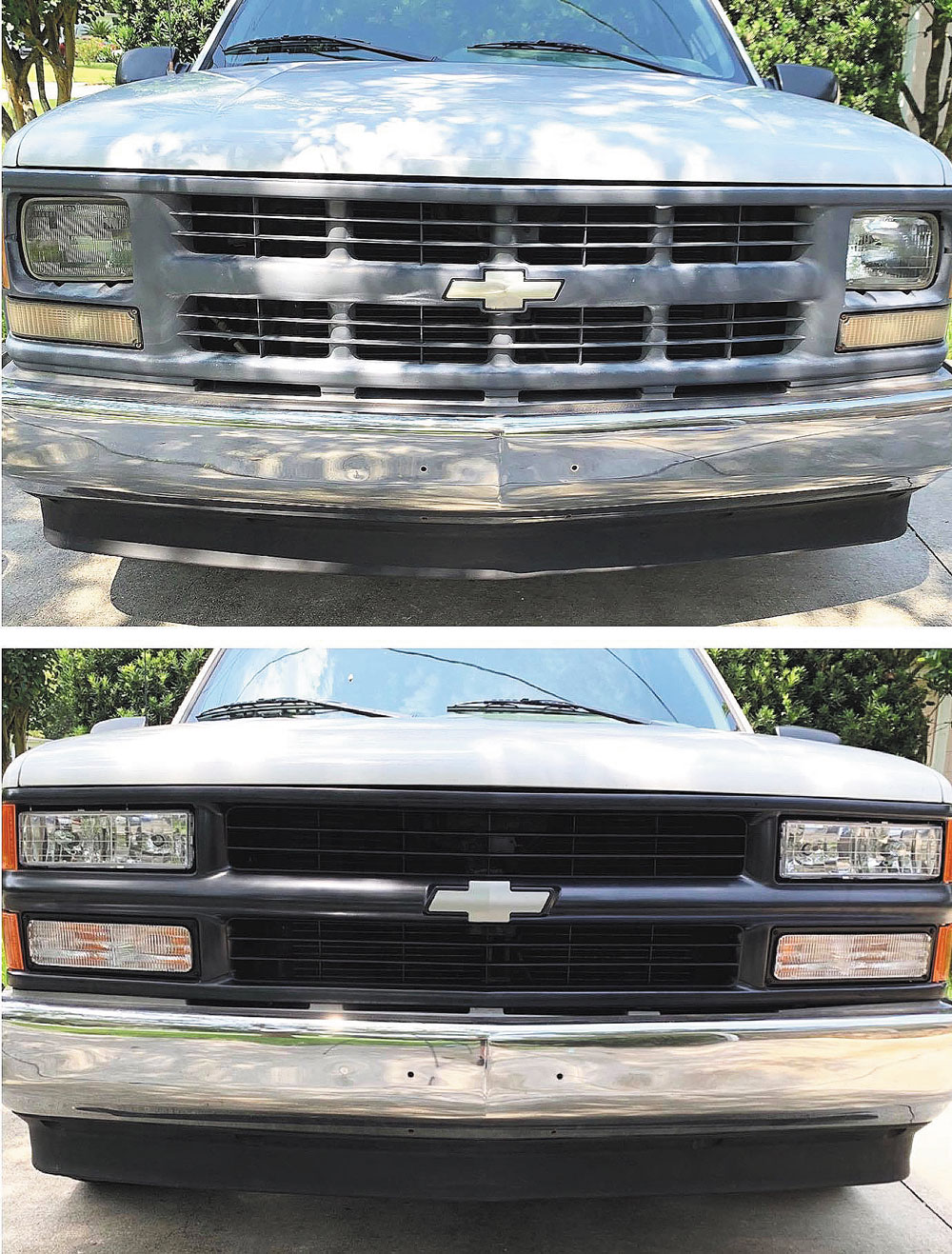We owe a lot to the pioneers of this passion of ours. There was a time when trucks, though useful, were boring. As folks eventually started to customize and personalize them, they began looking awesome, especially when lowered. The only problem was the ride quality was often severely lacking. Some people still hold that decades-old belief, saying things like, “I had a lowered truck in the ’70s and it rode like crap, always hitting the bumpstops.”
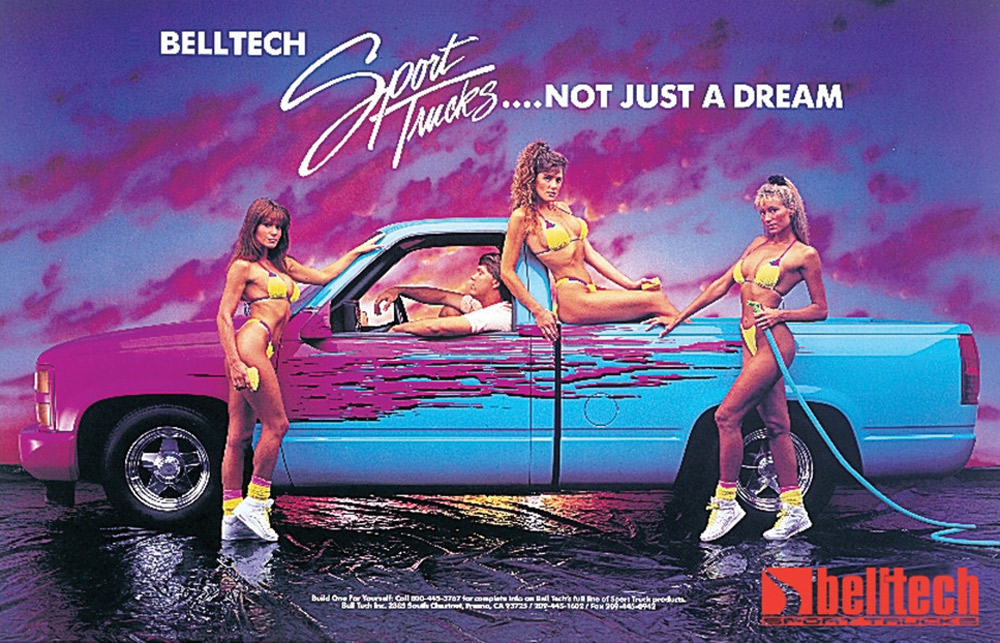
Well, that was then, and this is now. And the now wouldn’t be here if it weren’t for companies like Belltech, which paved the way with innovations like drop spindles, shackles and axle flip kits. When the ’88 Chevy and GMC ½-ton pickups debuted in late 1987, the custom truck world changed forever and the sport truck world as we know it was born.
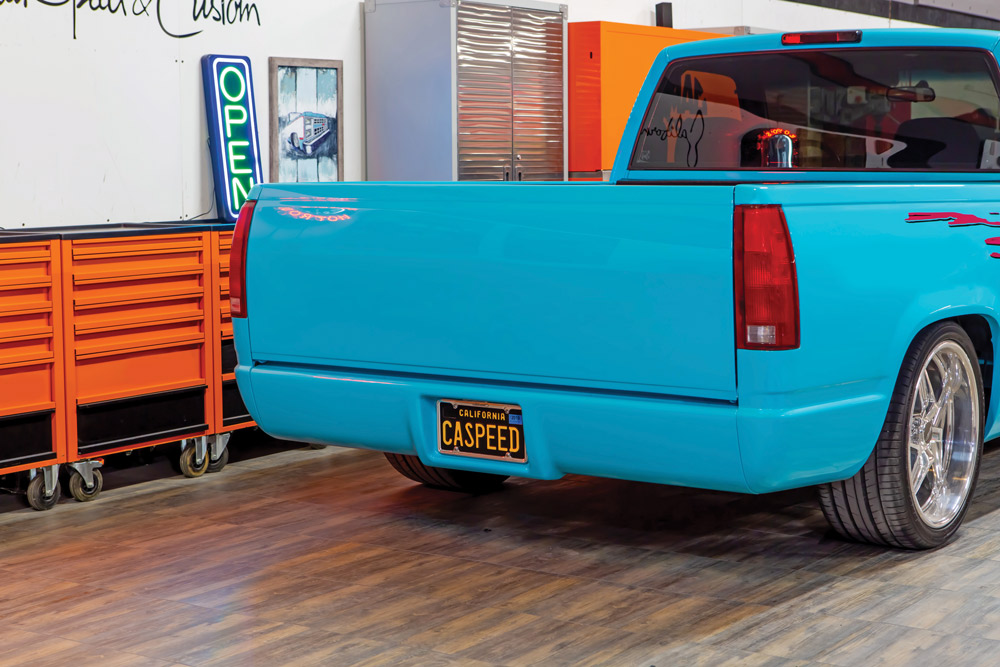
From seemingly out of nowhere, bright custom trucks became the hottest things on the streets, eclipsing popular mini-trucks almost overnight and becoming a staple in magazines.
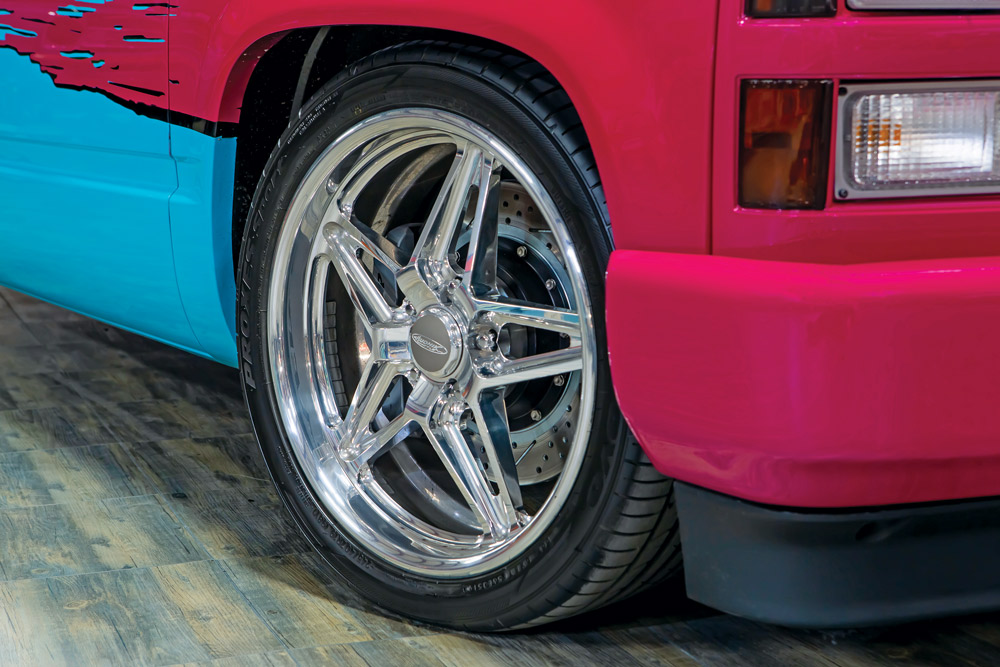
Mark Oja knows this era firsthand, as he was a young Canadian hot rod builder who had his finger on the pulse of all the latest automotive trends in the late ’80s and early ’90s. Like many of us, he was immediately drawn to these new trucks, especially after seeing a certain Belltech ad in a magazine. Mark began dropping trucks on billet wheels and giving them awesome paintjobs, both for himself and his customers, and hasn’t looked back since! He would eventually move his family to the States and open up California Speed and Custom, not to mention become the build manager for Overhaulin’.
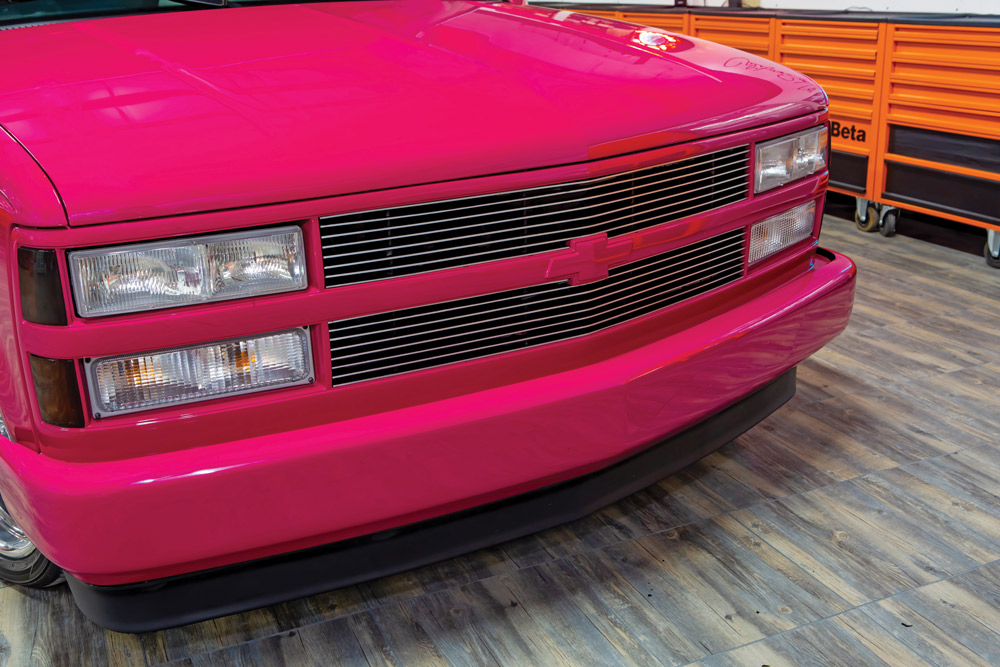
Fast forward to last year, and Mark’s wife Pattie was looking for a new daily driver. Mark, coincidentally, wanted to put together a cool truck for SEMA, and Pattie had her eye on one of the C1500s in their stash at the shop. The question now was, how to build it?
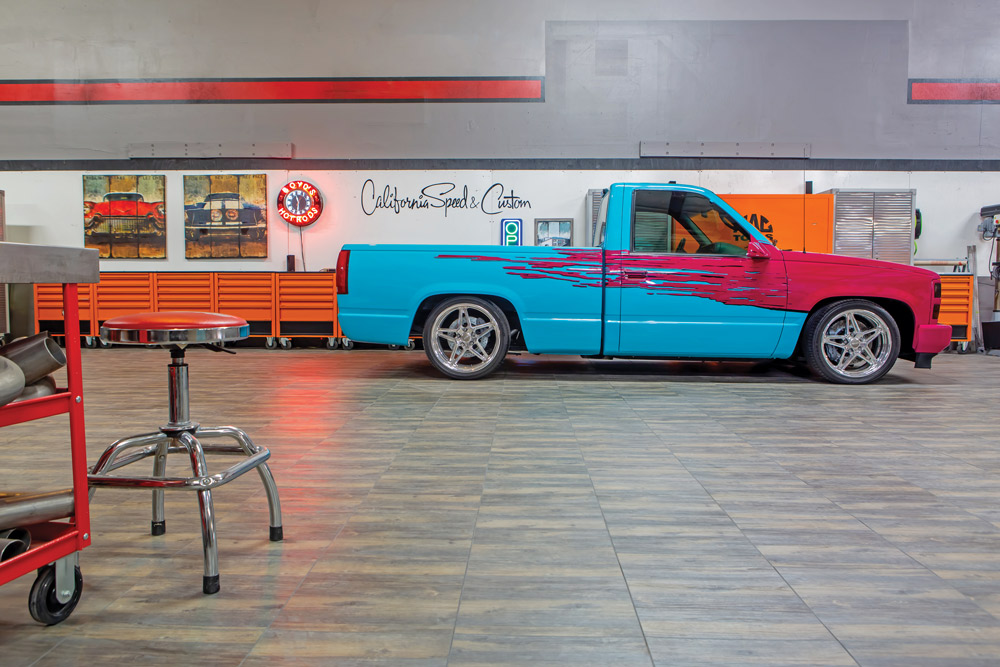
Pattie and Mark had been digging through old magazines to get some inspiration, and soon realized that a full-on retro build was in order. Specifically, a tribute to one of the trucks that started it all, the original Belltech poster/ad truck. Designed by Thom Taylor and painted by Pete Santini, the truck would come to define what a sport truck should look like.
For a bit of background, we got in touch with Thom and Pete, who shared their experiences with the legendary truck.
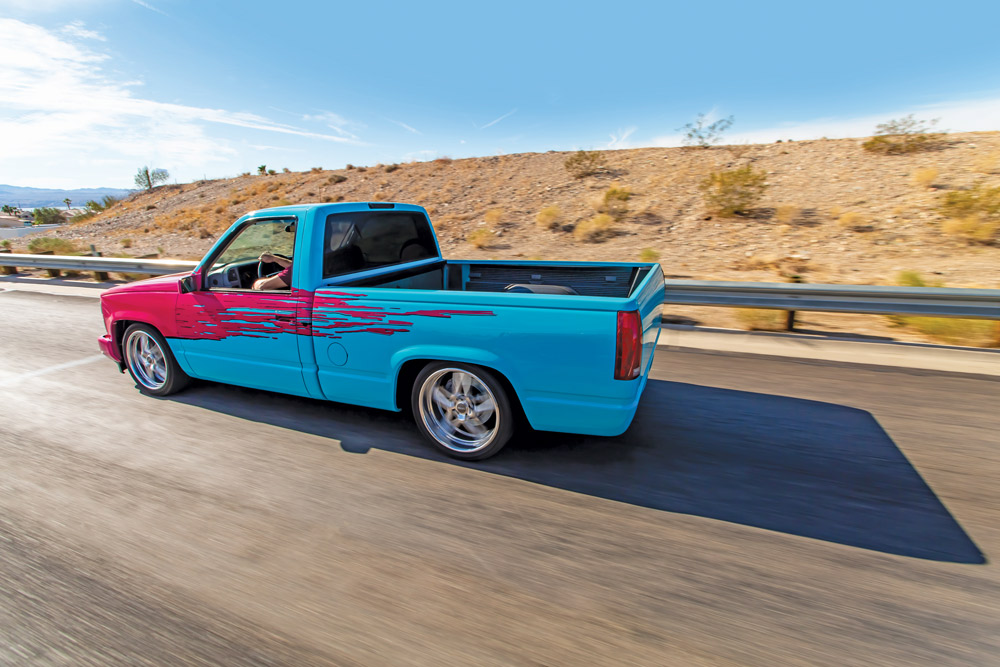
“I was friends with the owner of Belltech and Super Bell, Jim Ewing,” recalls Thom. “Jim Morris was handling their marketing and we came up with the idea to use digital graphics after seeing the GMC Truck Motorsports Syclone at Bonneville. It had these graphics that looked like salt was getting kicked up, but they didn’t just look like traditional taped-off graphics. I created the rendering and went to Pete Santini and asked him if he wanted to get involved, and he said yes. We just wanted to do something different than the heartbeat graphics that were being done at the time.
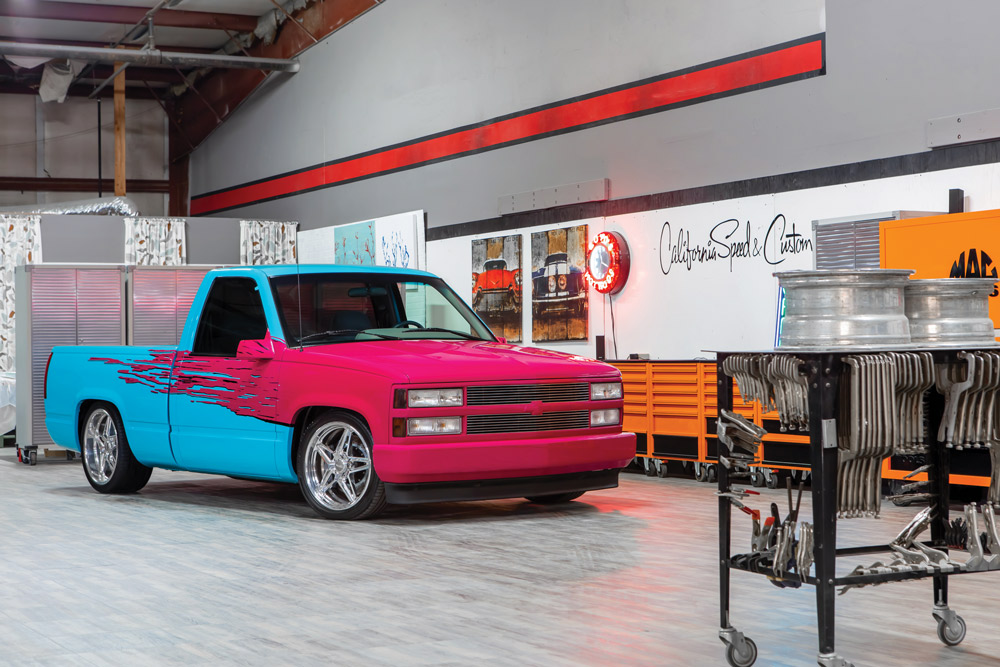
“I went to a vinyl sign place in Irvine and asked them if they could cut large sections of their vinyl masking material, and they said they could,” Thom says. “They cut the graphics I brought to them and weeded out the graphic part. From there, we applied the masking material to the truck and Pete painted the graphics on. It kinda caught on and I ended up drawing up more graphics for a series of trucks that they would use to dominate the magazine ads.”
Pete shared what was involved on the technical side of things.
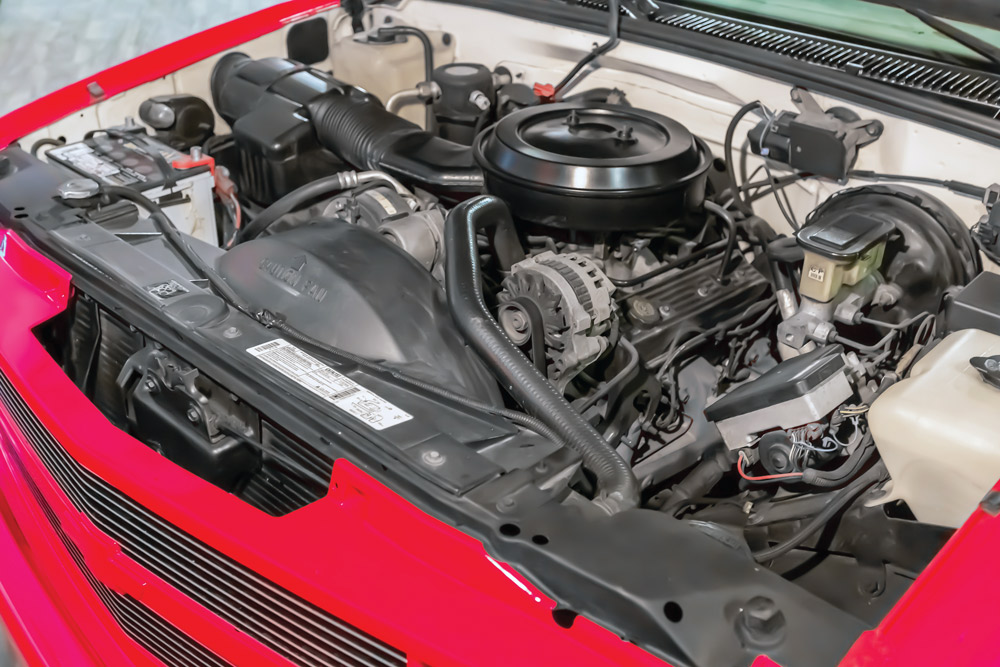
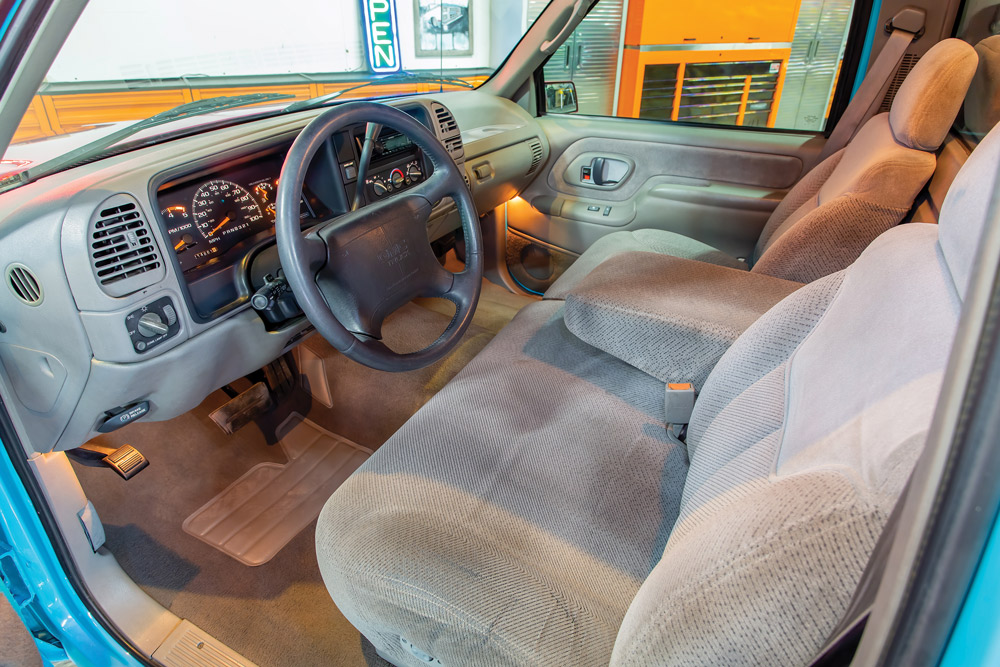
“They used something called Gerber paper, which is low tack,” he says. “The regular stuff they were using at the time was too strong and would lift paint. And you had to do it right so you wouldn’t have to use a lot of paint. It had to be thin so I wouldn’t end up with a thick tape line, and it was really interesting to register the drop shadows to get it just right. When we took the truck to SEMA, it was amazing how many people tried to pick the graphics off with their fingers—they thought it was vinyl!”
So Mark quickly gathered the parts necessary to build Pattie’s truck in just two weeks. But, as a skilled painter, he wanted to tackle the color himself! After checking in and getting some advice from Pete, Mark took off with the project and had the digital graphics recreated by Dave, Ryan, and Ryno and Coast Airbrush in Anaheim, California, then delivered the artwork to Mack Signs in Lake Havasu City, Arizona, to have the reverse digital mask cut. Finally, Mark called on his friends at House of Kolor to send some its Tropical Turquoise, an undisclosed shade of magenta paint and Show Klear.
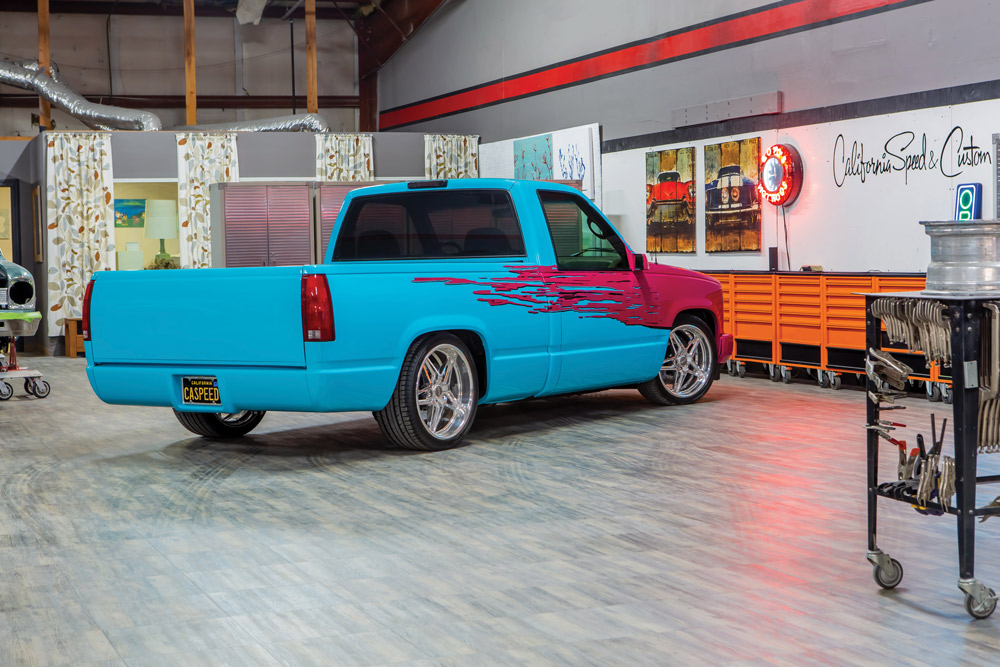
Before laying down the color, though, Mark had some work to do on the body. The flipped tailgate handle was pretty standard fare, but one clever trick Mark employed was to reshape the lower rear quarters to better match the contours of the steel roll pan (which awesomely looks like a vintage fiberglass pan!). And then there’s the lower grille filler and front fender extensions below the Carriage Works grille, which were molded in just like the old days. Once the cab and bed were tidied up, the famous paint scheme was carefully masked off and sprayed in the same manner in which it was done 30 years ago.
The rest of the truck came along pretty easily in comparison, with an authentic, period-correct 4/6 Belltech drop kit and a C-notch bringing the Chevy down to the perfect static height. Now, Pattie did want to bring the truck into the 21st century a bit, so 15-inch wheels weren’t going to cut it this time around. Instead, she went with 19×9 and 20×11 Budnik Argon billets with Toyo Pro XES Sport 245/40R19 and 295/30R20 rubber, but not before having Mark install Baer 14- and 12-inch brake rotors with 6-piston and 4-piston Baer calipers.
As was typical of the era, nothing under the hood was touched, save for the addition of a 2.5-inch Borla exhaust. The same can be said for the interior, which received a simple Pioneer head unit and single-amp setup with four Pioneer speakers and a single 10-inch subwoofer.
Finished just in time for SEMA 2019, Pattie’s truck made plenty of attendees do a double take. In fact, Thom Taylor was admittedly caught by surprise, as he had no idea the tribute was in the works.
“I saw the photos of it at SEMA,” Thom says. “And I didn’t know if it was the original truck or a copy!”
It was only after speaking with Pete Santini that he found out that Mark had built this truck to honor the work of those who created the original “street truck.”
OBS refers to Chevy C/K trucks that were manufactured by General Motors between the years 1988 and 1998. Marketed under the Chevrolet and GMC brands, the C/K series included a wide range of vehicles including a truck and two SUV models. While most commonly associated with pickup trucks, the model line also included medium-duty and heavy-duty trucks. The “C” denoted a two-wheel drive; “K” denoted four-wheel drive.
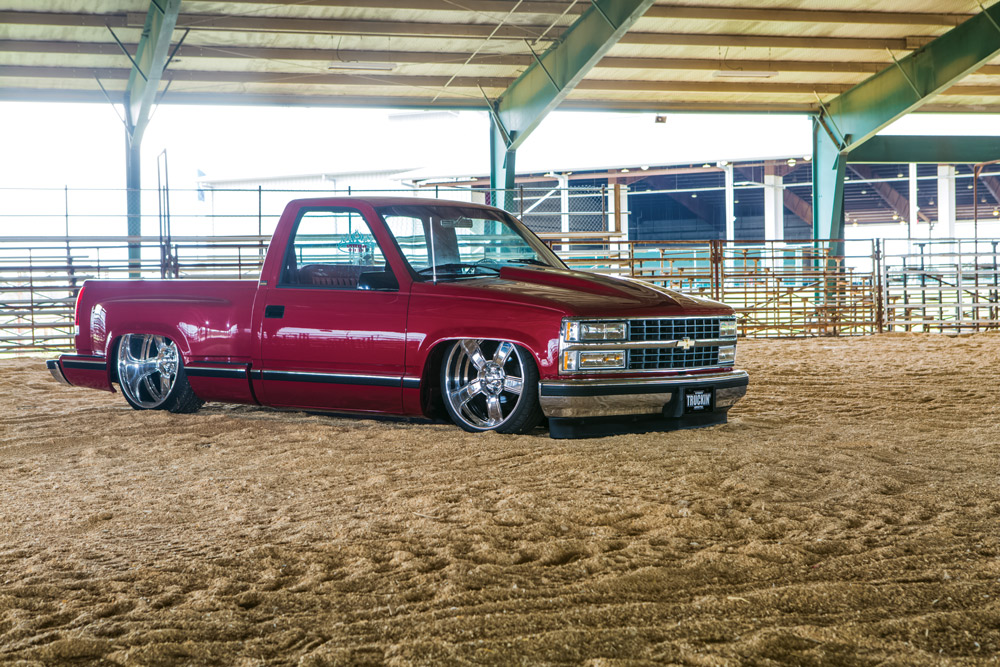
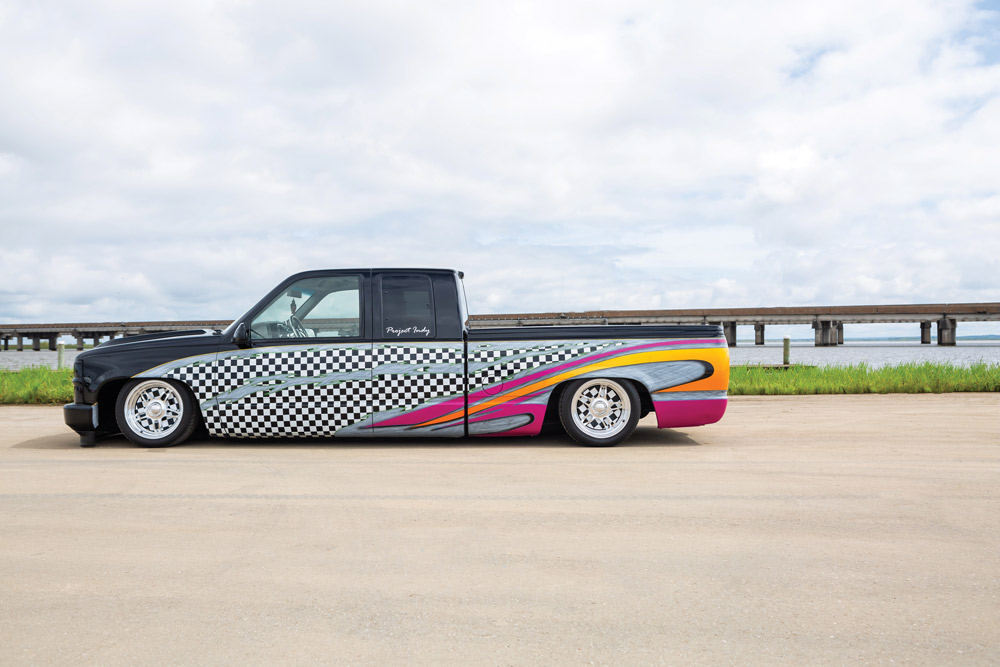
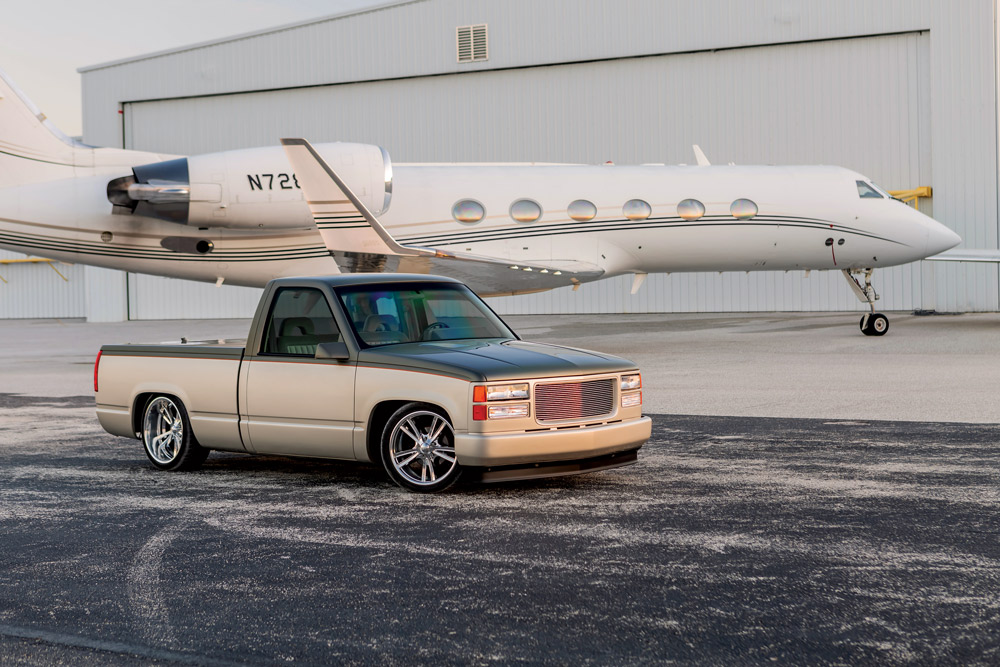
General Motors released eight different versions of the C/K line for 1988: Fleetside Single Cab, Fleetside Extended Cab, Fleetside Crew Cab and Stepside Single Cab models, each in either 2WD or 4WD drivelines. Three trim levels were available for these trucks, including Cheyenne, Scottsdale and Silverado.
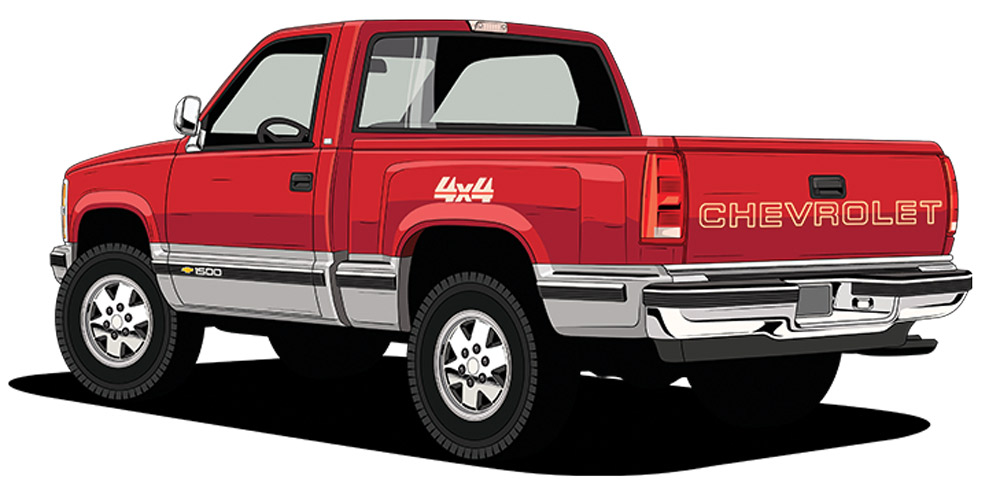
GMT400/480 ’88–’00 Chevrolet C/K – GMC Sierra
GMT410 ’92–’99 Chevrolet Suburban
GMT415 ’92–’94 Chevrolet Full-Size Blazer
GMT420 ’95–’00 Chevrolet Tahoe
GMT425 ’92–’99 GMC Suburban
GMT430 ’92–’00 GMC Yukon
In 1989, a Sport Equipment Package was available on either C/K 1500 Fleetside shortbed single cab model. The package featured a black grille with red outlined bow-tie emblem, black moldings outlined in red, body color front and rear bumpers, black mirrors and “SPORT” identification decals on the box and on the tailgate. There were no suspension or engine upgrades provided with any of the sport packages as this was an appearance only option.
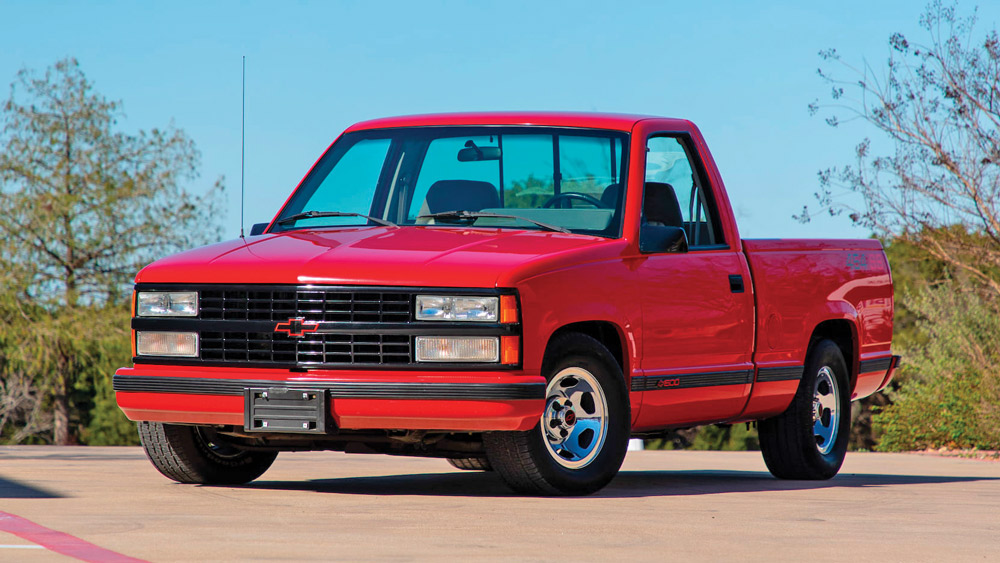
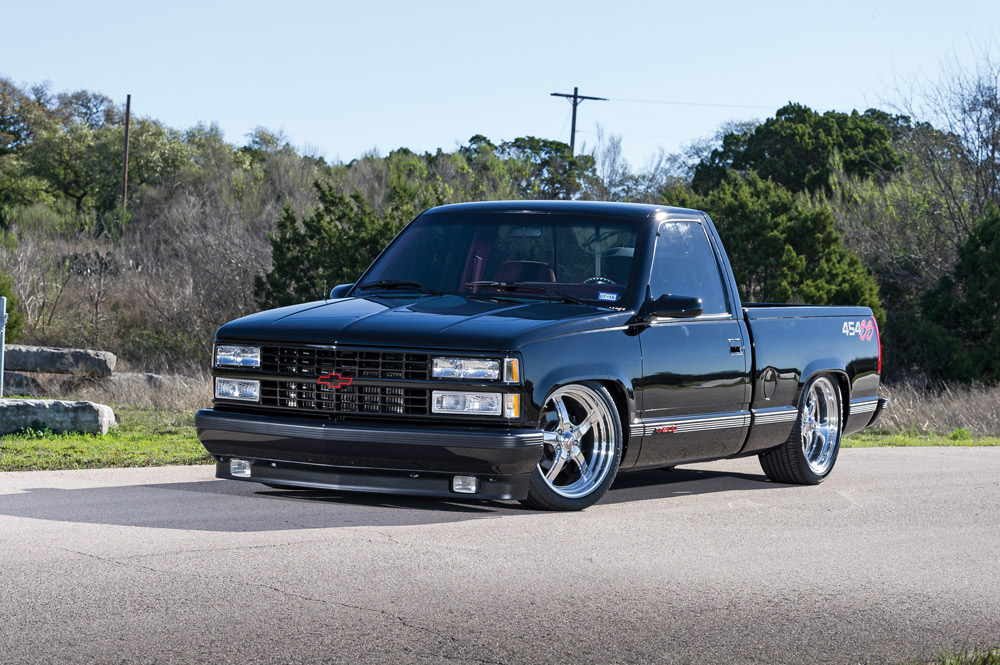
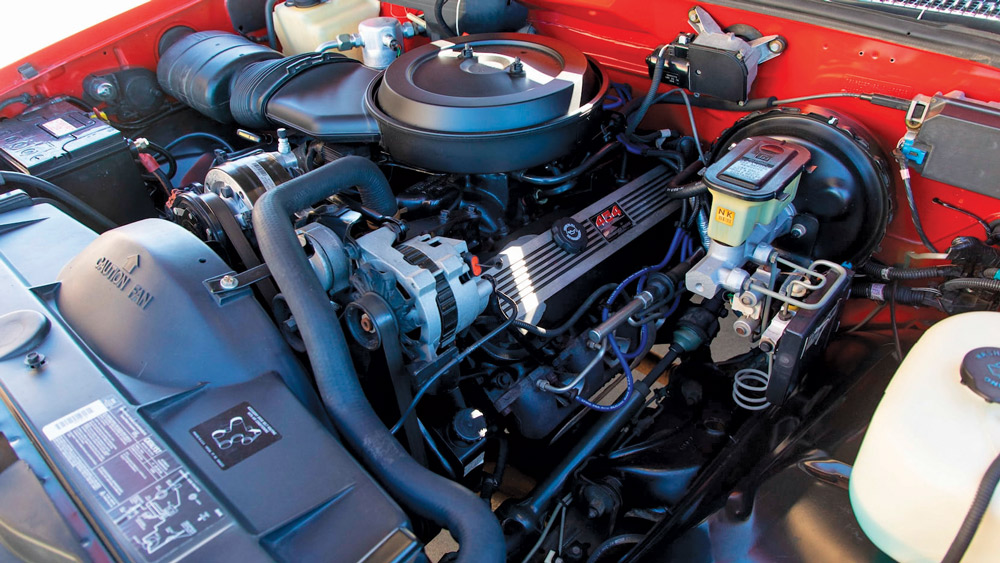
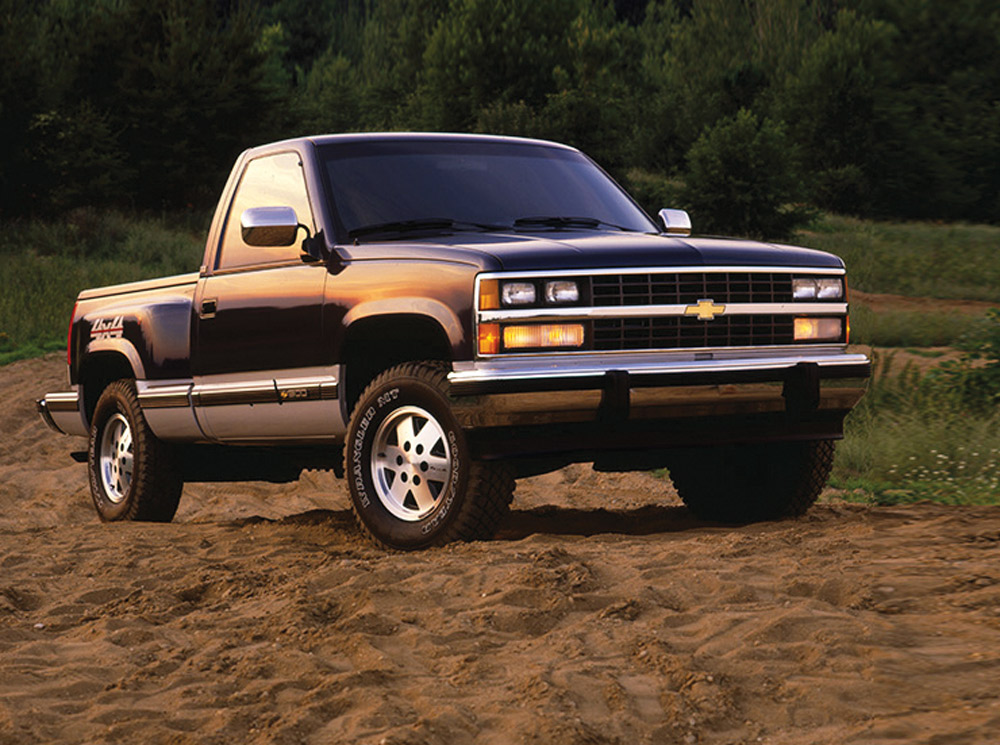
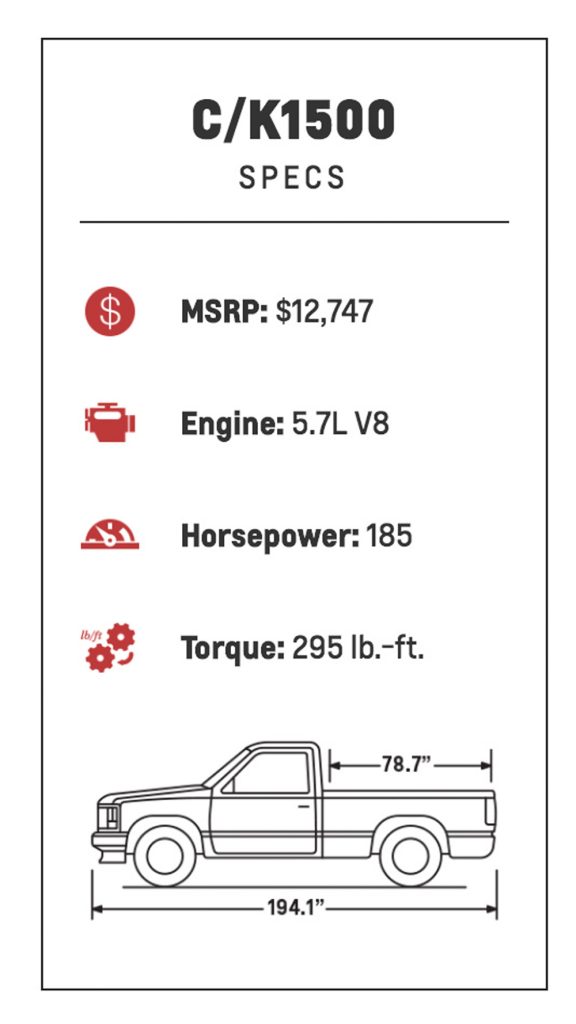
Throttle body (TBI) fuel injection was used on ’88-’95 gas engines.
Central point injection (CPI) was used on the ’96-’00 4.3L V-6, 5.0L V-8 and 5.7L V-8.
The Work Truck (W/T) was introduced in 1988, which featured a single cab longbed with Cheyenne trim and a new grille with black bumpers.
In 1990, Chevrolet introduced a high-performance variant of the GMT400 under the Super Sport emblem called the 454 SS. It was available only as a 2WD half-ton regular cab short box in Onyx Black with a garnet red interior. Unique exterior features included a front air dam with fog lights, special rims, decals displaying “454 SS” on the bed sides, red trim emblems, and black painted grille, bumpers and mirrors.
The MSRP of the 1990 model was $18,295. A total of 16,953 units were sold over the four years the 454 SS was in production; 13,748 units were sold in 1990 alone.
The 454 SS was powered by a 454ci (7.4L) V-8 producing 230hp. A Turbo Hydra-Matic 400, 3-speed automatic transmission and 3.73 rear axle ratio added to the truck’s performance. The axle itself is unique, being a 14-bolt semi-floating unit that uses standard Chevrolet 5 on 5-inch wheels—the only factory-produced 14-bolt axle with such a wheel bolt pattern.
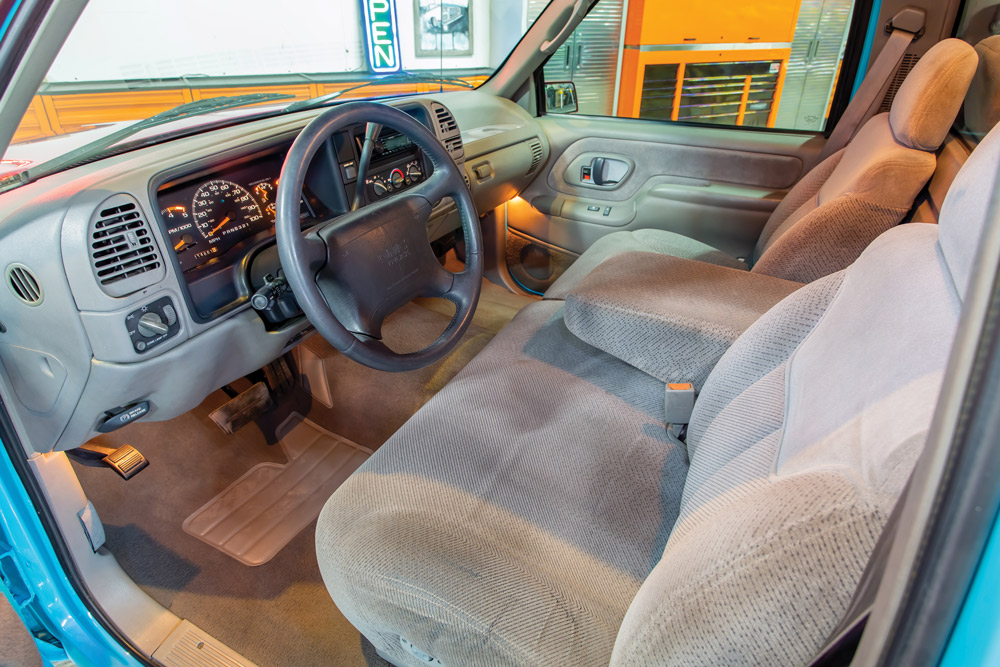
In 1991, the 4L80-E automatic transmission was added for three-quarter and one-ton trucks.
In 1991, California introduced a standard called OBD-I in order to curb vehicle emissions. All cars had to be equipped with a system that could detect engine issues and report trouble codes. Unlike the later OBD-II standard, however, OBD-I wasn’t standardized across manufacturers.
This means that an OBD-I scan tool will often work for only one make of car. In addition, the codes themselves aren’t standardized, so a Ford with the same engine issue as a Toyota might give a totally different trouble code.
In 1993 General Motors re-introduced the Sport branded trucks along with the 454 SS. The 454 SS was discontinued after the 1994 model year.
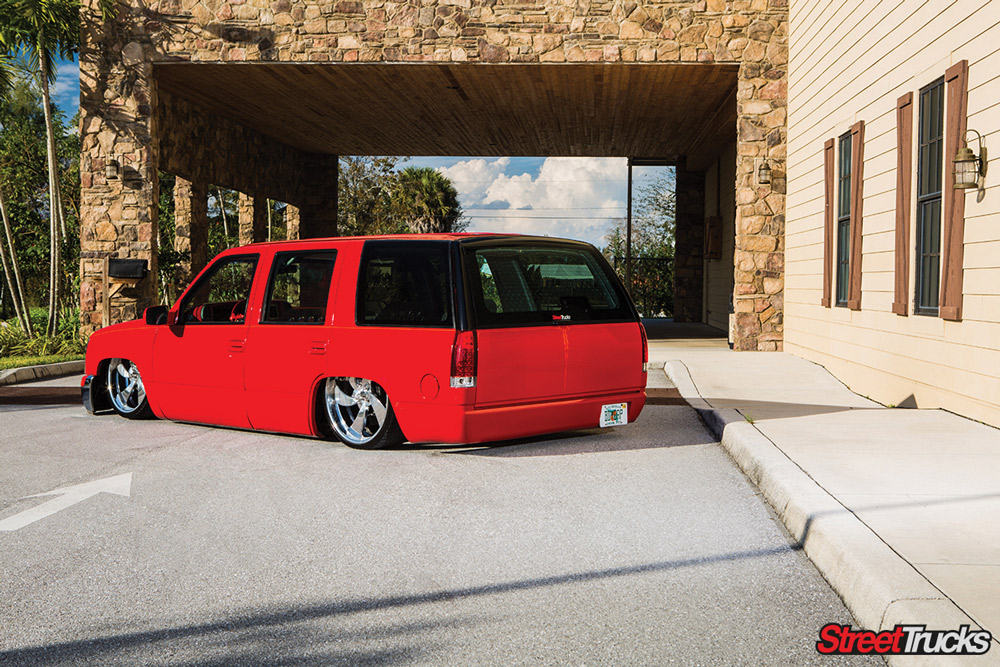
In 1993, the 700-R4/4L60 transmission was revised with electronic controls, becoming the 4L60-E.
The 1994 models received a new front fascia, federally mandated center high-mount stop lamp, many new exterior colors including a new two-tone option on the rocker panels, and new tire and wheel combinations.
All 1995 models received a new interior that included a new steering wheel with the 1500s containing a driver’s-side airbag, a new dashboard containing a more centrally mounted radio, dial-operated HVAC system, and an improved gauge cluster. New front door panels and new seats were also included.
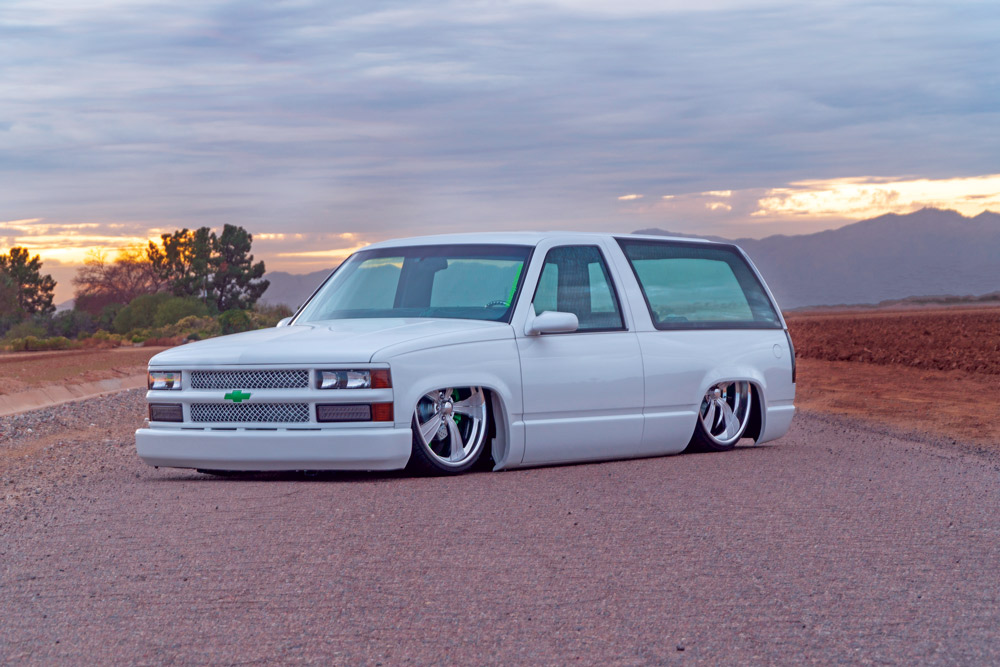
In 1996, OBD-II became a nationwide standard and it has been used ever since. Unlike OBD-I, OBD-II equipped cars all support the same type of scanner. The trouble codes themselves have also been standardized across all manufacturers.
For 1996, a passenger-side-mounted third door became optional on extended cab models.
C/K 1500 models received a passenger-side airbag for 1997 to comply with new federal regulations for light trucks.
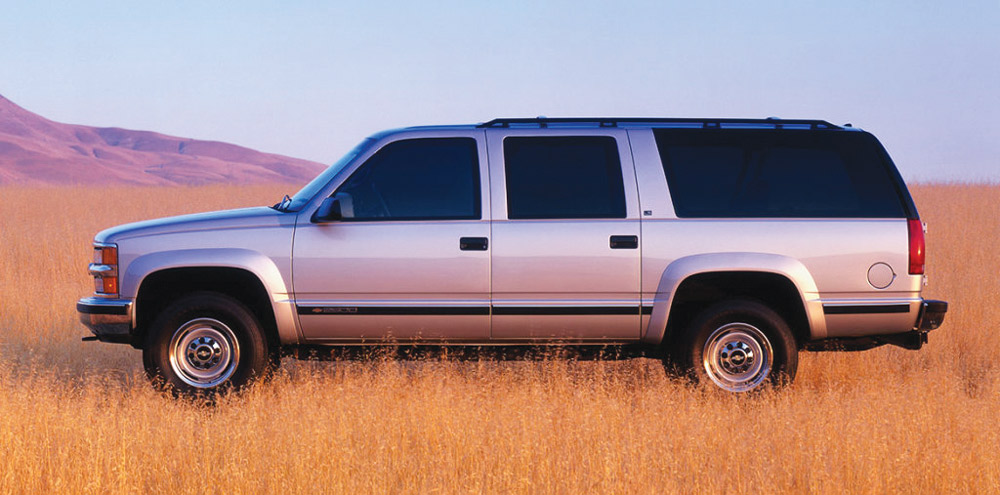
1997 was to be the last year the C/K Silverado would display “CHEVROLET” on the tailgate.
In 1999, the Chevrolet Silverado became the divisional replacement for the C/K.
The Chevrolet Tahoe is a full-size SUV from General Motors. Chevrolet and GMC sold two different-sized SUVs under their Blazer/Jimmy model names through the early 1990s. This situation changed when GMC rebadged the full-size Jimmy as the Yukon in 1991. All were two-door models through 1994.
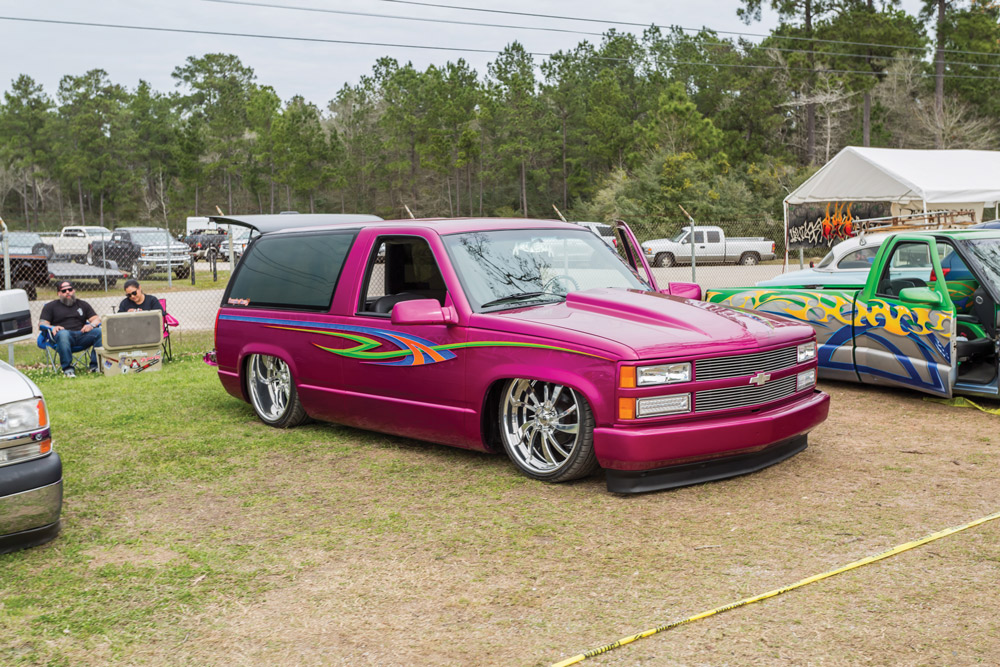
The Chevrolet K5 Blazer name was discontinued after the 1994 model year, and the Chevrolet Tahoe was introduced in 1995 with the addition of an all-new four-door version.
The Tahoe has regularly been the bestselling full-size SUV in the United States, frequently outselling its competition by 2 to 1.
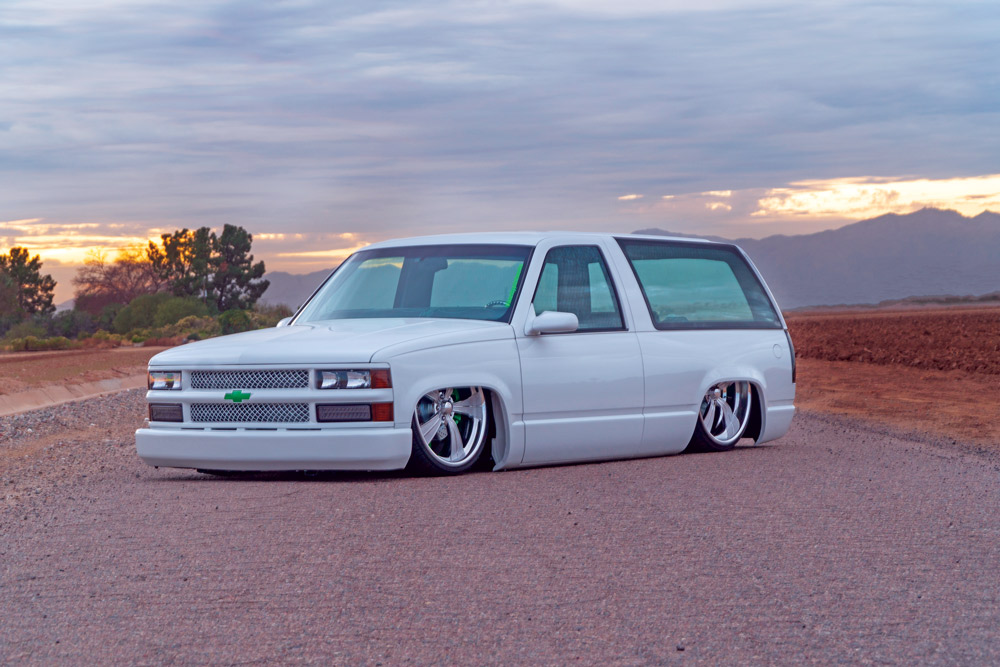
Both two-door and four-door models were produced in rear- and four-wheel drive. The two-door weighs roughly 4,500 pounds while the four-door weighs approximately 5,500 pounds. The two-door has a 6-inch shorter wheelbase than the four-door.
The standard engine was Chevrolet’s 5.7L (350ci) small-block V-8, while a turbocharged 6.5L (395ci) Detroit Diesel V-8 was available beginning in 1994.
The GMT400-based Suburbans were introduced in December 1991 for the 1992 model year even though the similar pickup truck models had switched to the newer platforms in the 1988. Both 2WD and 4WD models, designated “C” and “K”, were offered, as well as half ton and three-quarter ton versions.
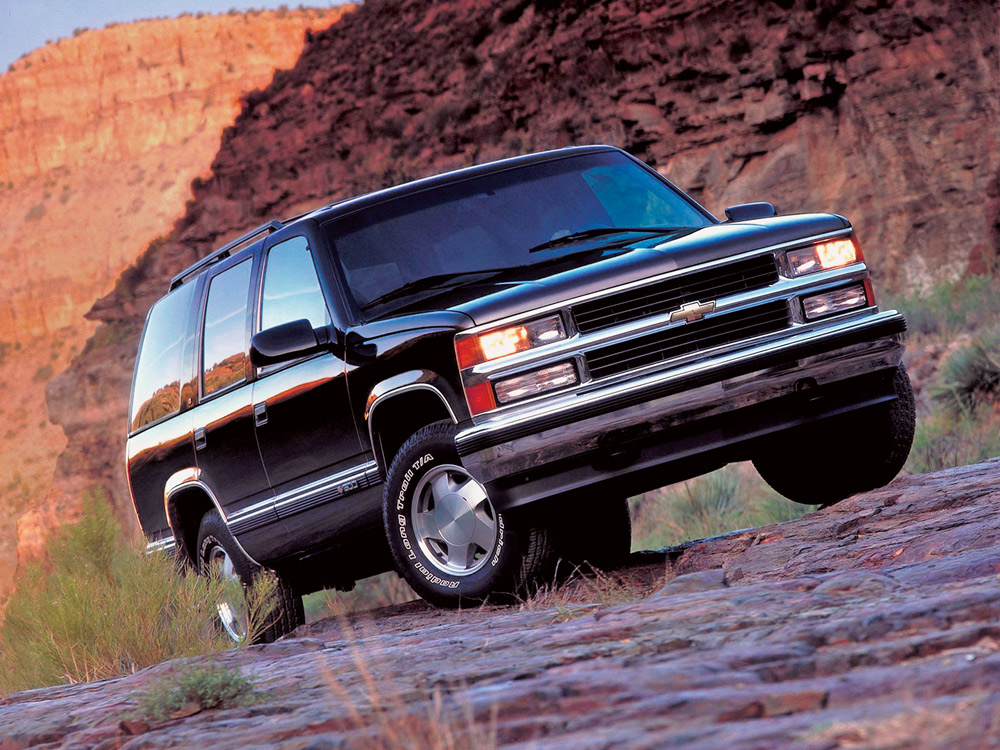
The GMT400 series introduced independent front suspension. The 2WD models used coil springs and 4WD models used torsion bars in the front suspension. All models used a live axle and leaf springs in the rear.
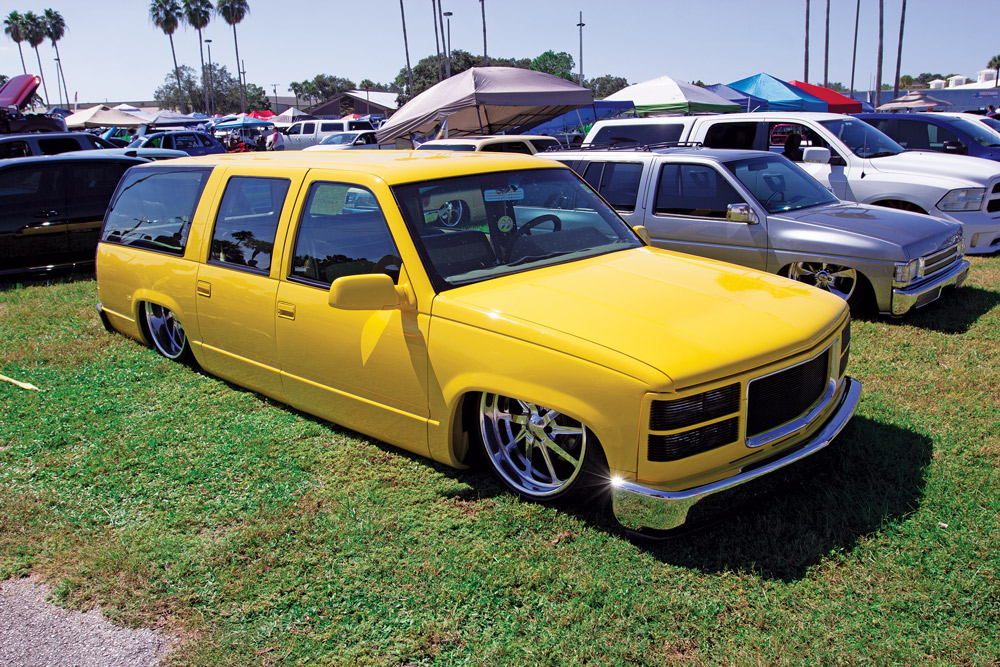
For a 1995 Suburban, 0–60 mph times were around 9.3 seconds at best. The top speed of a 1995 Suburban was governed on the engine for economy and a maximum of 98 mph could be obtained with a fuel economy of 13 mpg.
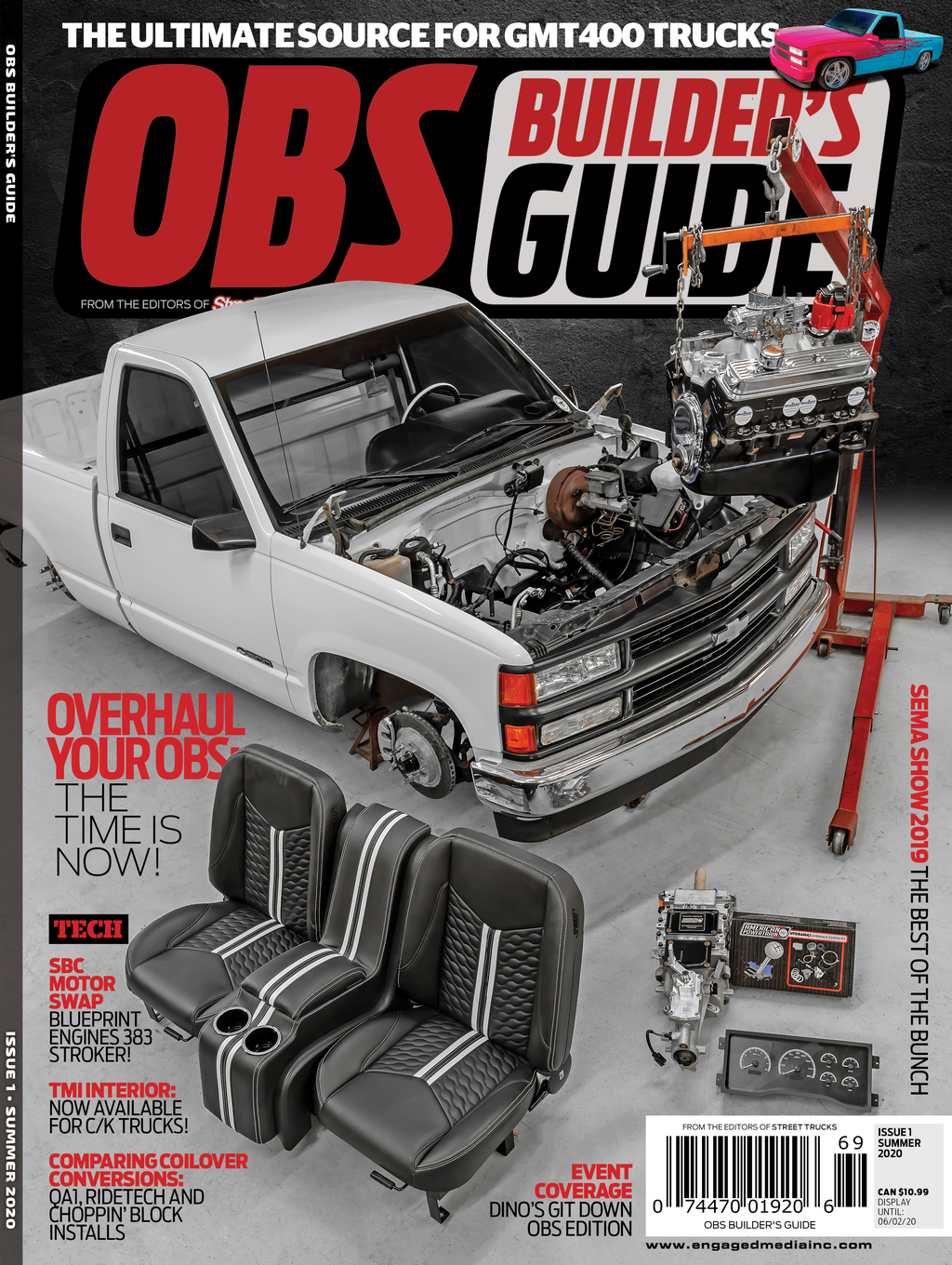 From the editors of Street Trucks Magazine comes the all-composing guide to restoring and customizing one of the most popular body style trucks ever released. Chevrolet’s 88-98 Fullsize trucks and SUVs spawned a massive sub-culture of passionate enthusiasts, artists, and gearheads worldwide. With over 800,000 OBS (Old Body Style) trucks built and sold within the first year of production, it’s easy to see why this is one of America’s most beloved bodies. The OBS Builders Guide is here to document this trend-setting truck and bring you the best how-to tech, feature stories, manufacture spotlights, event coverage, and new product reveals that relate.
From the editors of Street Trucks Magazine comes the all-composing guide to restoring and customizing one of the most popular body style trucks ever released. Chevrolet’s 88-98 Fullsize trucks and SUVs spawned a massive sub-culture of passionate enthusiasts, artists, and gearheads worldwide. With over 800,000 OBS (Old Body Style) trucks built and sold within the first year of production, it’s easy to see why this is one of America’s most beloved bodies. The OBS Builders Guide is here to document this trend-setting truck and bring you the best how-to tech, feature stories, manufacture spotlights, event coverage, and new product reveals that relate. 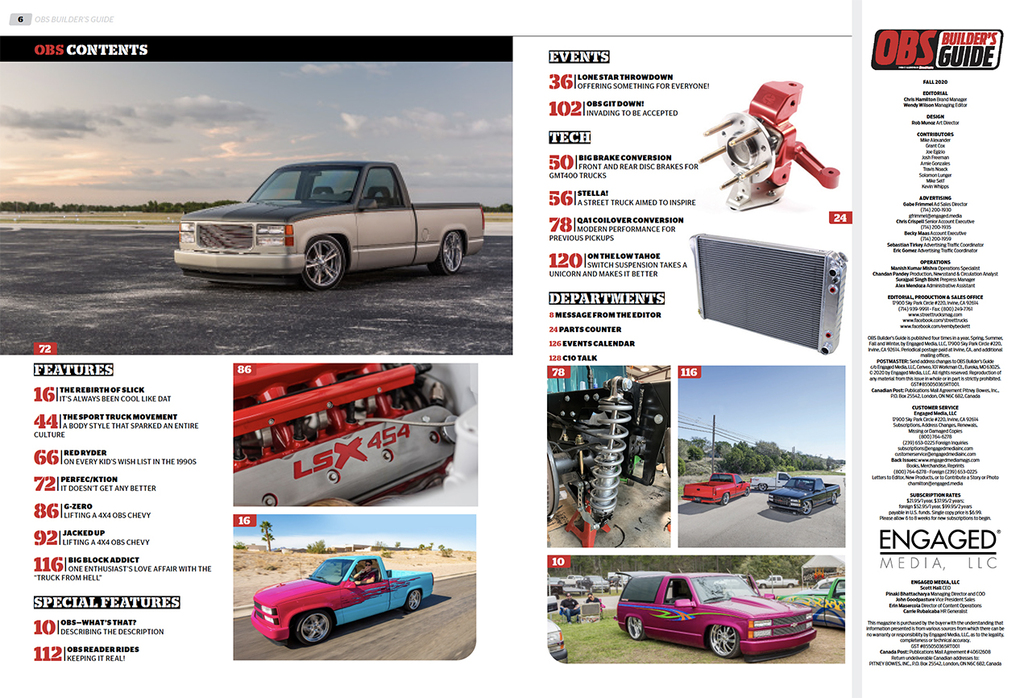 In this book you will see:
In this book you will see:
FEATURES
THE REBIRTH OF SLICK | IT’S ALWAYS BEEN COOL LIKE DAT
RED RYDER | ON EVERY KID’S WISH LIST IN THE 1990S
PERFEC/KTION | IT DOESN’T GET ANY BETTER
G-ZERO | LIFTING A 4X4 OBS CHEVY
JACKED UP | LIFTING A 4X4 OBS CHEVY
BIG BLOCK ADDICT | ONE ENTHUSIAST’S LOVE AFFAIR WITH THE “TRUCK FROM HELL”
SPECIAL FEATURES
THE SPORT TRUCK MOVEMENT | A BODY STYLE THAT SPARKED AN ENTIRE CULTURE
OBS? WHAT’S THAT? | DESCRIBING THE DESCRIPTION
OBS READER RIDES | KEEPING IT REAL!
EVENTS
LONE STAR THROWDOWN | OFFERING SOMETHING FOR EVERYONE!
OBS GIT DOWN! | INVADING TO BE ACCEPTED
TECH
BIG BRAKE CONVERSION | FRONT AND REAR DISC BRAKES FOR GMT400 TRUCKS
STELLA! | A STREET TRUCK AIMED TO INSPIRE
QA1 COILOVER CONVERSION | MODERN PERFORMANCE FOR PREVIOUS PICKUPS
ON THE LOW TAHOE | SWITCH SUSPENSION TAKES A UNICORN AND MAKES IT BETTER
DEPARTMENTS
MESSAGE FROM THE EDITOR
PARTS COUNTER
EVENTS CALENDAR
C10 TALK
CORONA, California, June 1st, 2020 –TMI Automotive Products Inc., the industry-leader in Restomod and OE Match replacement interiors, released their custom interior line for the 1988-1998 Chevy C/K truck. After its unveiling at the 2019 SEMA Show in Las Vegas last November, inquiries have flooded in on social media, email and phone as to when the long-awaited line would be released.
“The Chevy OBS truck is the hottest new truck trend. They are readily available and have an inexpensive cost of entry,” said Jonathan Frank, Vice President of Sales & Marketing, TMI Automotive Products Inc “We’ve taken the same recipe we use for all of our interiors and created one that perfectly fits this highly sought after truck, while letting the customer have the ability to express their individual style.”
The TMI Product Development department focused not only on aesthetics but also on ergonomics– a component the competition often overlooks– by test-fitting different body types and hand-molding the door panels and consoles. The new line is a complete interior-in-a-box and is easily installed in a weekend. Everything you need from sun visors to bucket seats, door panels and dash pads are available. The OBS line gives the customer the ability to express their own style with multiple style/insert patterns as well as thousands of color & material combinations.
Optional contrast stitching, grommet detail, and suede inserts are just some of the ways customers can create a personalized interior and as always, they are manufactured in Southern California, U.S.A.
Since TMI manufactures all aspects of the interior in-house, from pouring the foam to laying the fiberglass, they have the ability to control what premium materials they use, test fit to ensure it’s right the first time, and keep costs low to better pass the savings onto the customer.
For more information, please visit our website at www.tmiproducts.com or call (951)-272-1996.
About TMI Automotive Products, Inc.
TMI Automotive Products, Inc. was established in 1982 by four brothers in their parent’s Southern California garage. As an ever-expanding catalog that continues to impress and inspire, TMI has gained recognition and praise from car-lovers and distributors nation-wide. TMI Products has bestowed something on the classic automotive industry that every vintage vehicle owner dreams of: the ability to maintain the quintessential style of their beloved car while simultaneously making it all their own. For more information, please visit www.tmiproducts.com.
Billet Aluminum Hood Hinges for 1988-98 Chevy C/K Trucks
Fits 88-98 C/K Chevy/GMC Trucks
92-99 Blazer/Jimmy/Suburban/Tahoe Yukon
●High strength, precision billet aluminum construction
●Utilizes sealed bearings & stainless steel nitrogen gas struts (included) for smooth operation
●Bolt-on application for steel, fiberglass, or carbon fiber hoods (specify when ordering)
●Available in raw machined or bright polished finish as well as a variety of Fusioncoat and anodized colors
●Sold in pairs
●Made in the USA
Generally, truck trends are unpredictable and cycle quickly through the ranks of the top industry builders and ballers. F-100 bump-sides and pro-touring, patina-paneled C10s are just a few recent examples of popular projects that the average Joe wouldn’t think to produce until they see a fully completed custom gracing the pages of national publications or influential social media channels. These ideas and completed concepts come from the mindset of being unique with the goal of making a statement at massive events like SEMA, LST and Texas Heatwave. With that said, I think it’s safe to say we all see the next major trend hurling down the pipeline like a 6-foot surfer named Bodhi riding a 15-foot wave off Bells Beach during the 50-year storm. (That was a “Point Break” reference if you didn’t catch it. What a great ’90s movie!)
Speaking of the ’90s, if you were a natural born truck junkie finally making it to the legal driving age around those times, you most certainly wanted a Chevy C/K truck since they were literally everywhere. Everyone from utility company employees to school district secretaries used these heavily produced pickups for their day-to-day operations. Even your grandpa’s grocery-getter was most likely an ’89-’98 Chevy. They came in so many different visual styles with factory options galore. Originally designed by Donald Wood in 1983, Chevy was able to move 551,223 of these GMT400 trucks by 1989 alone according to the Standard Catalog, not to mention the popular 454 model released in 1990 that sold 16,953 units over the four years with 13,748 of those units selling in the first year of production alone.
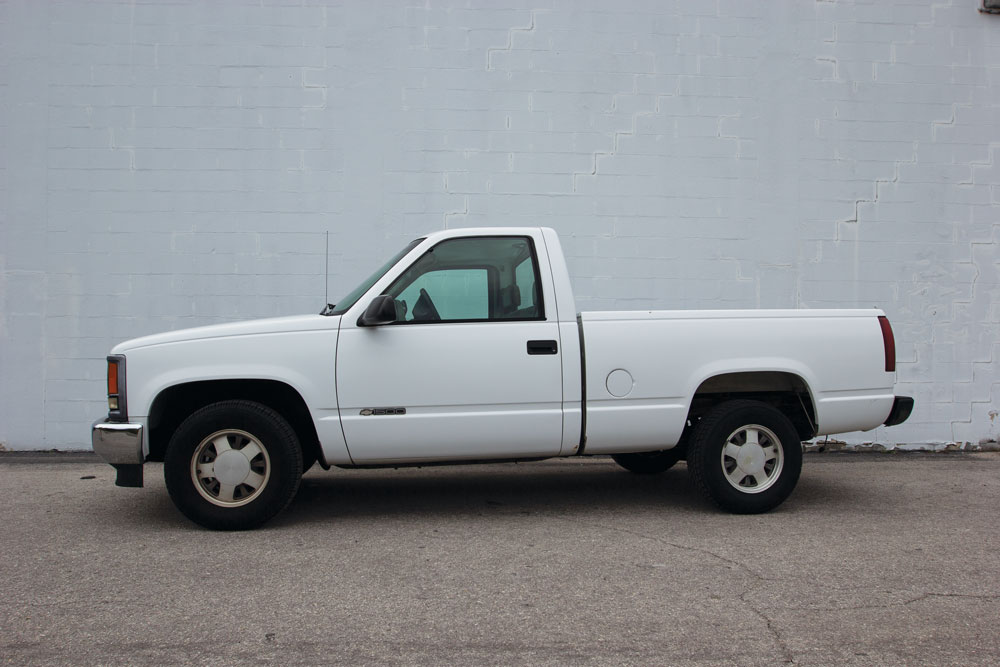
This is the 1995 Chevy C/K that we originally picked up for a mere $2,000. We purchased it from the original owner, it has 150,000 miles on the factory installed engine, cold air conditioning and a handwritten chart that records all of the basic maintenance that has ever been done. The perfect project truck, and we named her Stella for “female star” because we intend to make her famous!
With that heavy of a number, it’s easy to see why we not only saw a massive increase of these trucks in magazines, but also why the custom aftermarket scene is heating up so much right now. These trucks are still pretty easy to come by and the demographic of buyers are slightly older and more well-off than your average new-truck enthusiast. The guys who wanted these trucks in their teens are now older, generally successful and more comfortable than they were at 16 years old. These factors are driving the great custom parts manufacturers to focus on these industry icons to get ahead of the curve.
It’s easy to talk the talk, but it’s far more impactful to walk the walk. So, we put on our Airwalks and jumped into the deep end of desire by picking up a running, driving 1995 Chevy C/K truck from the original owner for a smooth $2,000. Cold A/C and a solid cranking 4.3-liter V-6 gave this truck the appeal, but a full gas tank and a fresh oil change just shows that the previous owner still has love for this 20-plus-year-old family member.
In the next few issues we are going to take you through the process of giving this truck new life on the same old roads it’s been cruising down since its inception, first starting with suspension, brakes and wheels/tires, followed up with a facelift for the ages. The plans don’t stop there, but you’re going to need to stick to the script the see the next steps. If you’re not a subscriber already, I implore you to do so. If this truck doesn’t motivate you to go out and start wrenching on your own project, I’m not sure you picked up the right publication. Now let’s get to the good stuff!
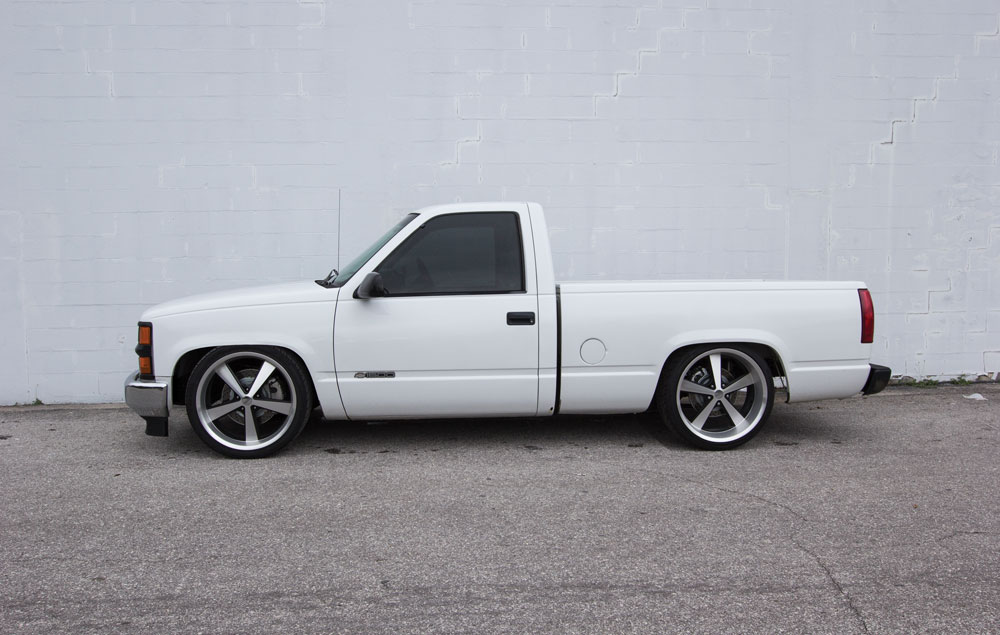
Usually we include the “after” shot toward the end of the story, but we wanted to show you the before and after side by side so you can see the dramatic transition. Now to walk you through how it was done.
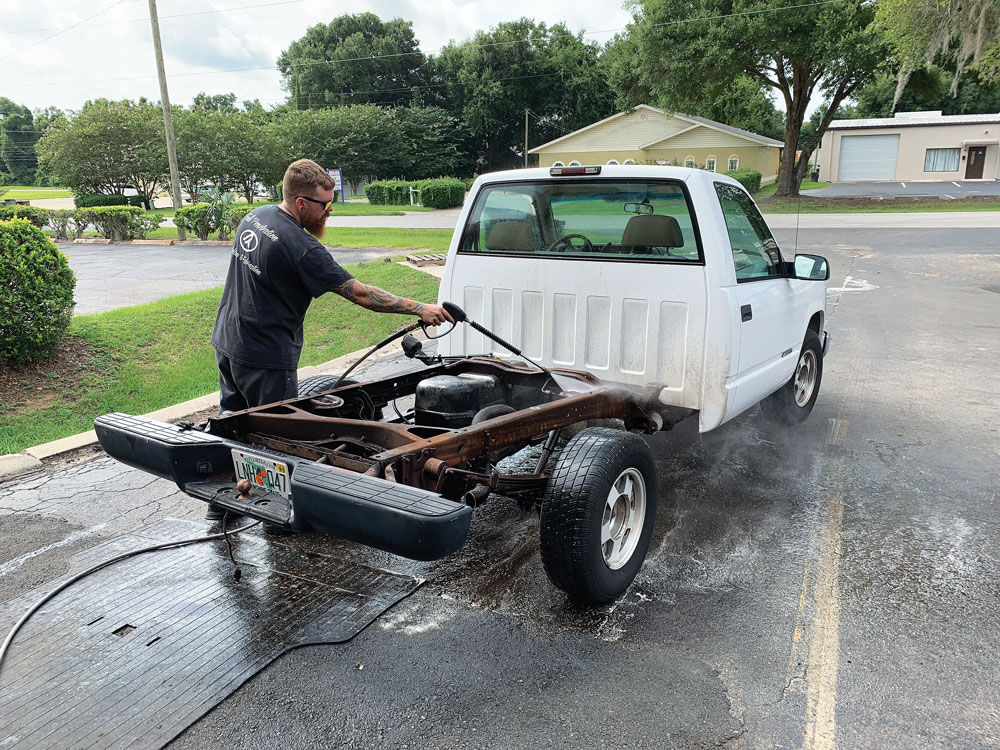
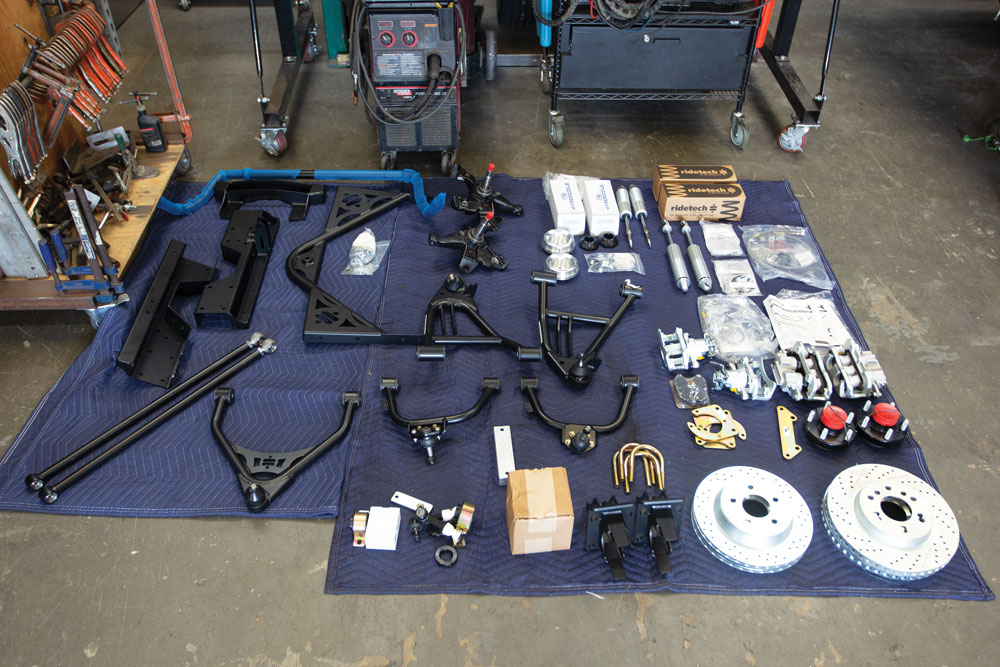
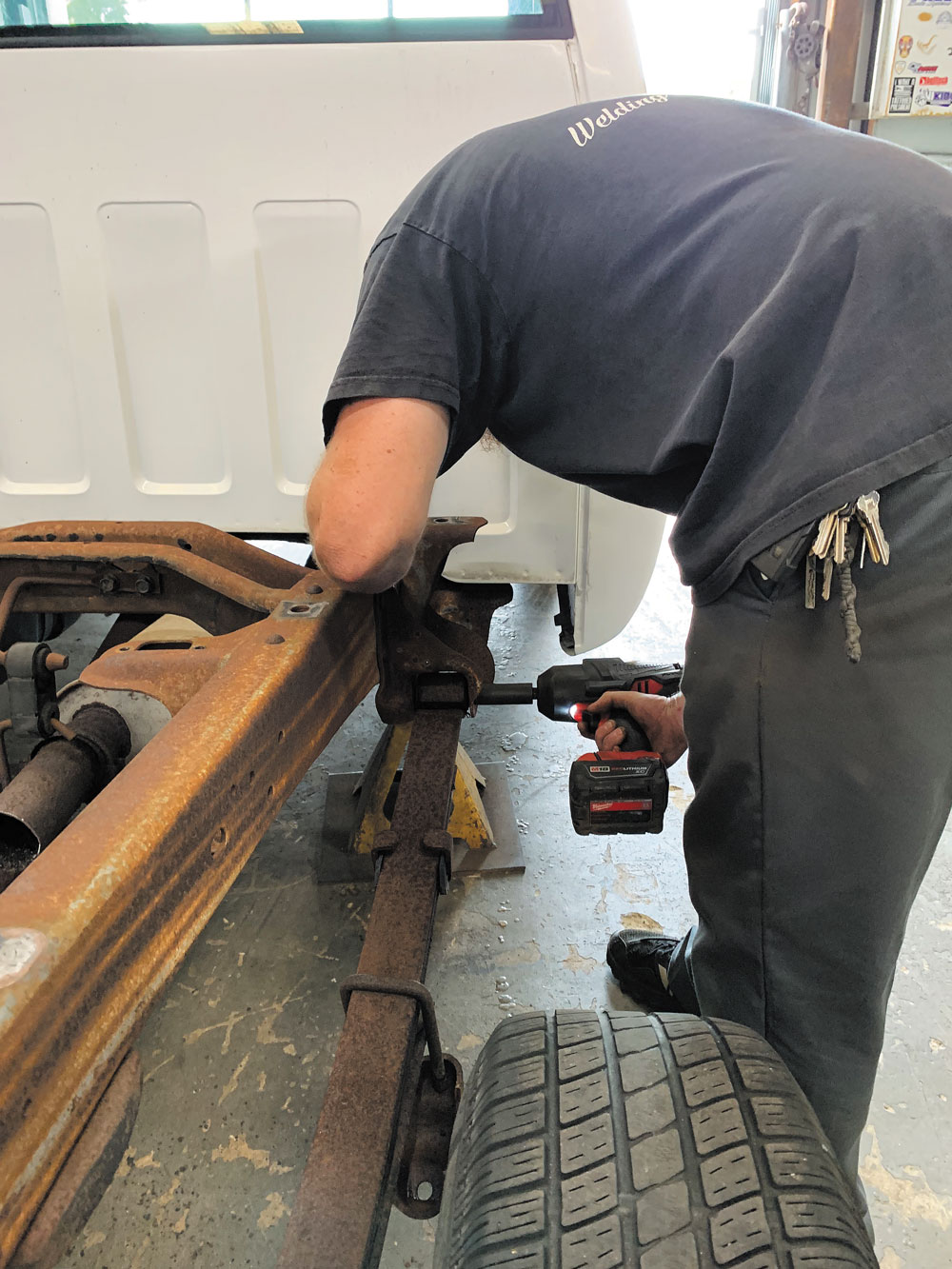
First on the list is to remove the old suspension hardware. Leaf springs are old news and completely obsolete with this kit.
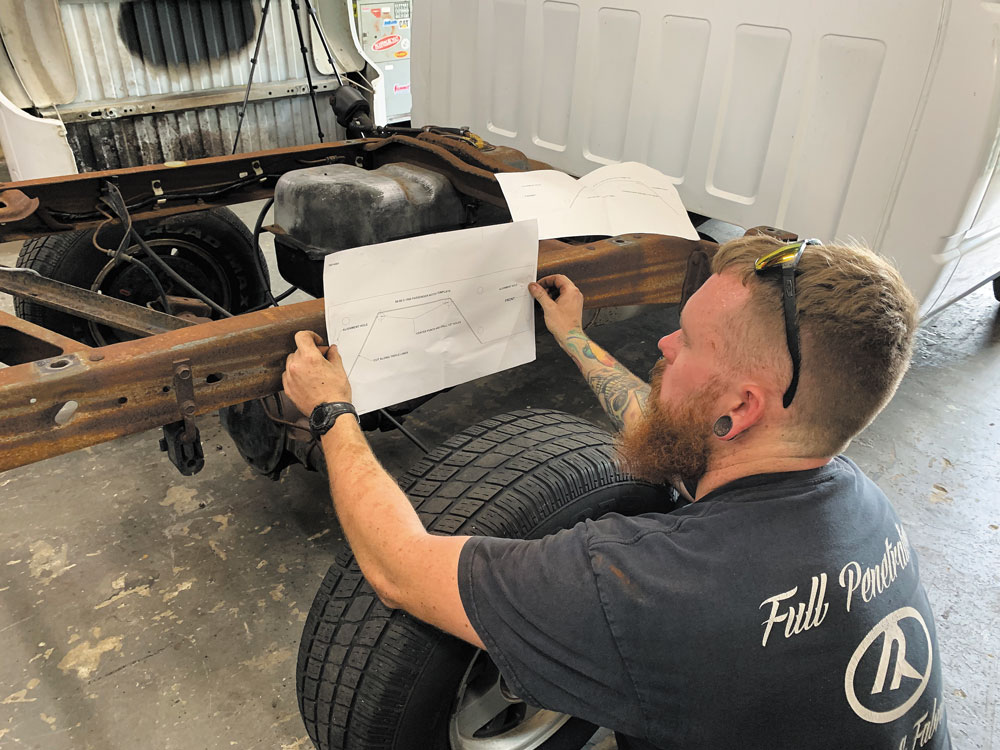
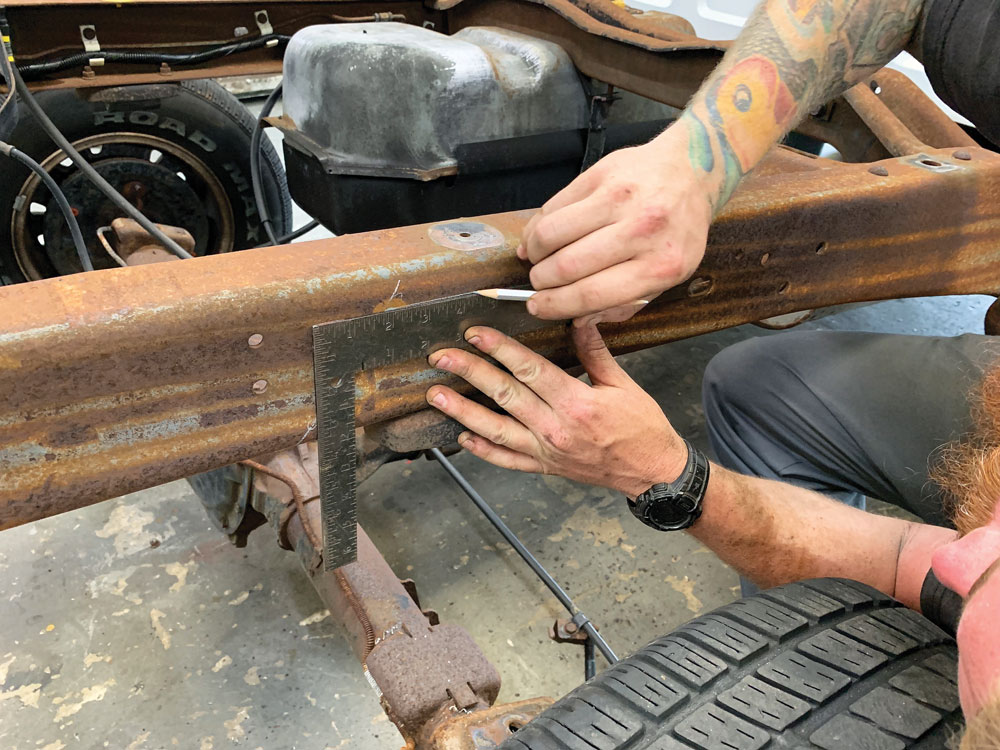
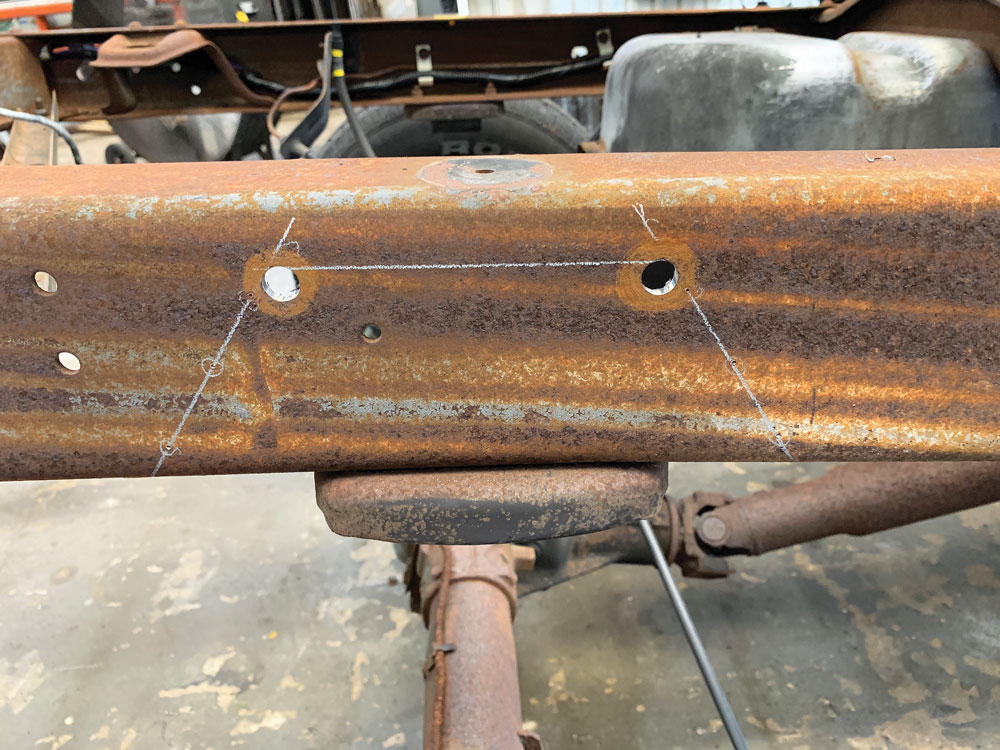
Using the supplied paper template, Dallas marked the C-notch location and used a cut-off wheel to slice the frame. Before the new structured brackets can go on, he took the time to coat the frame to avoid any more future rusting.
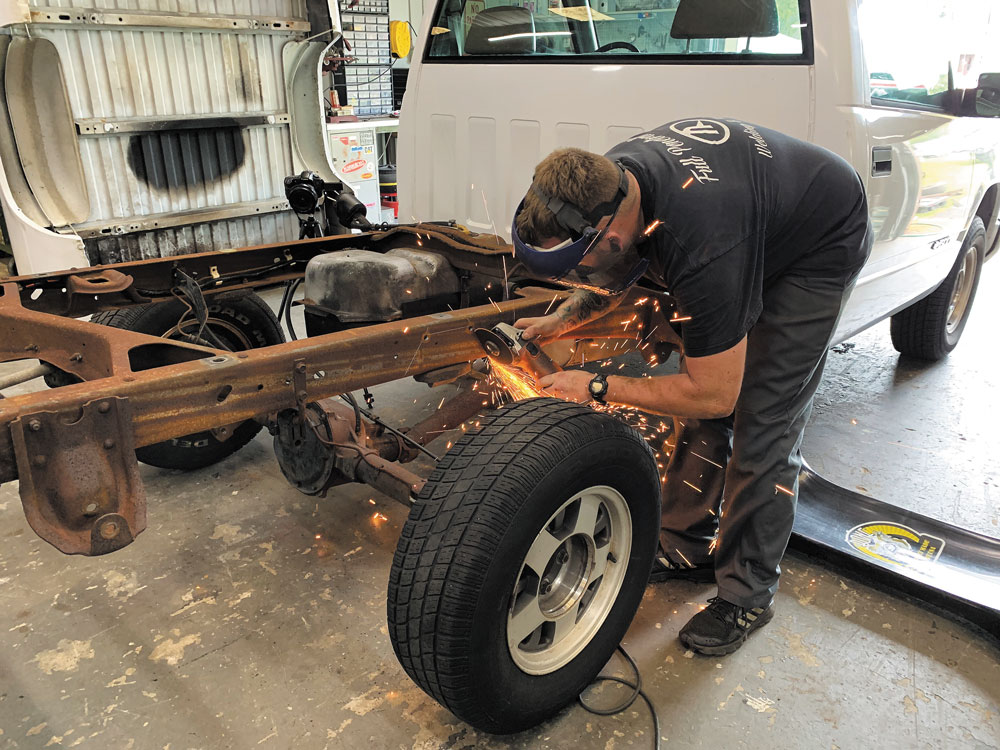
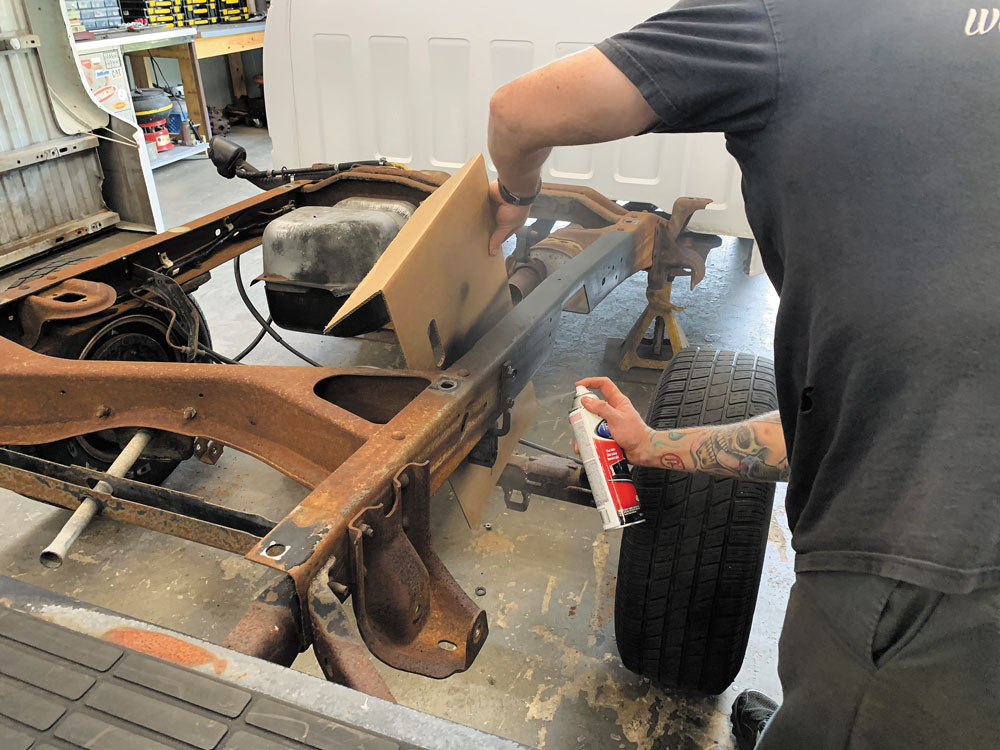
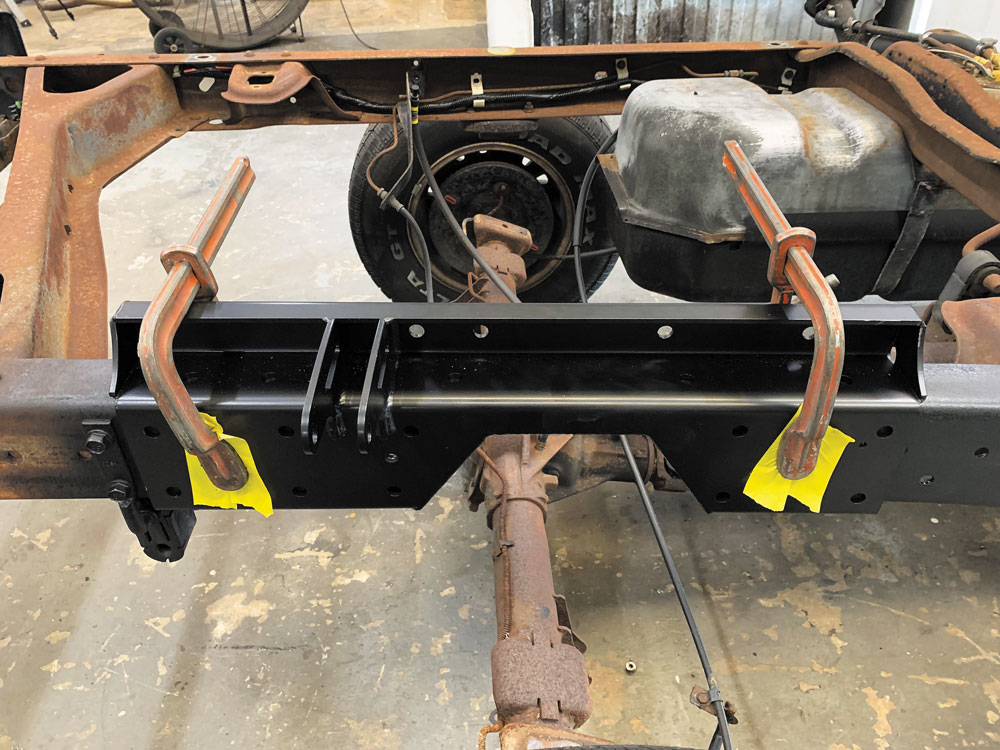
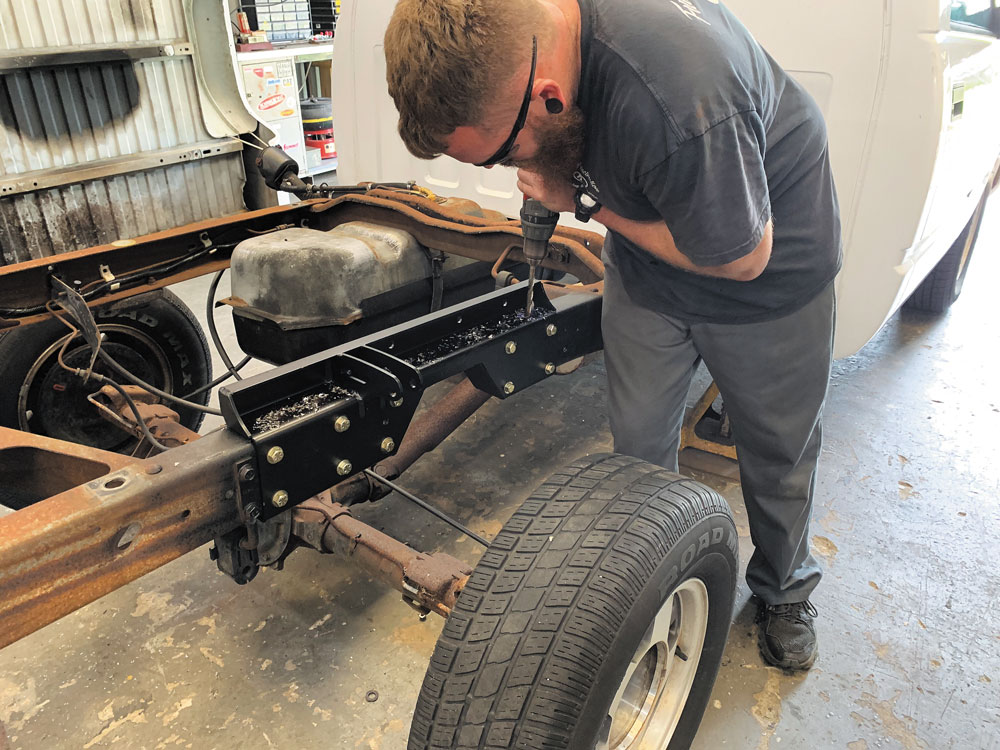
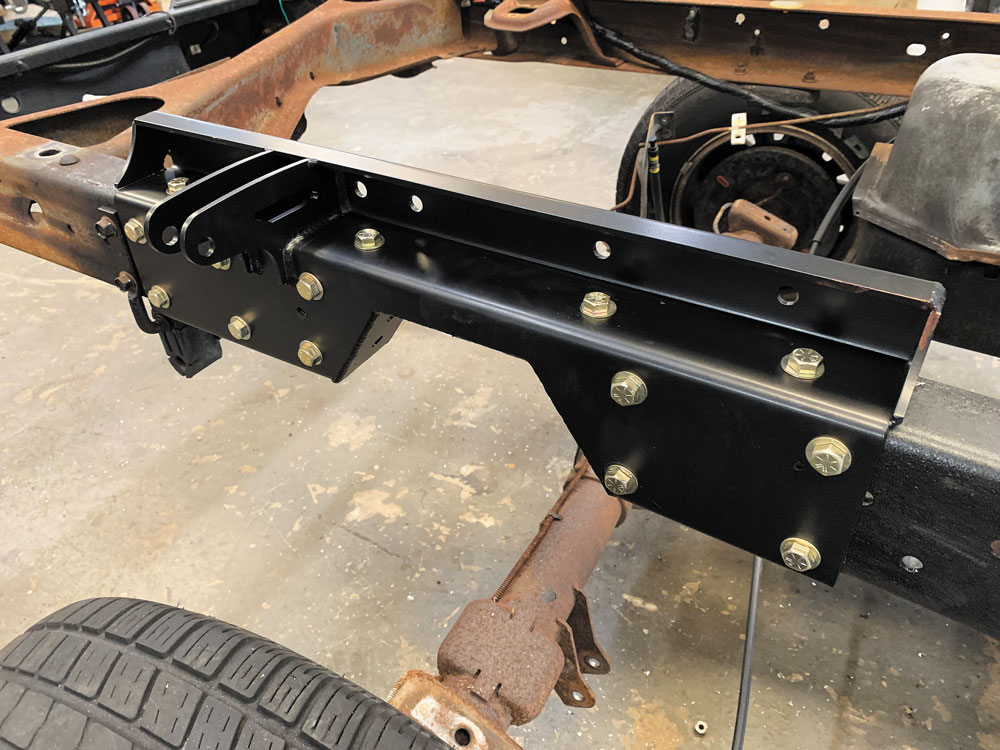
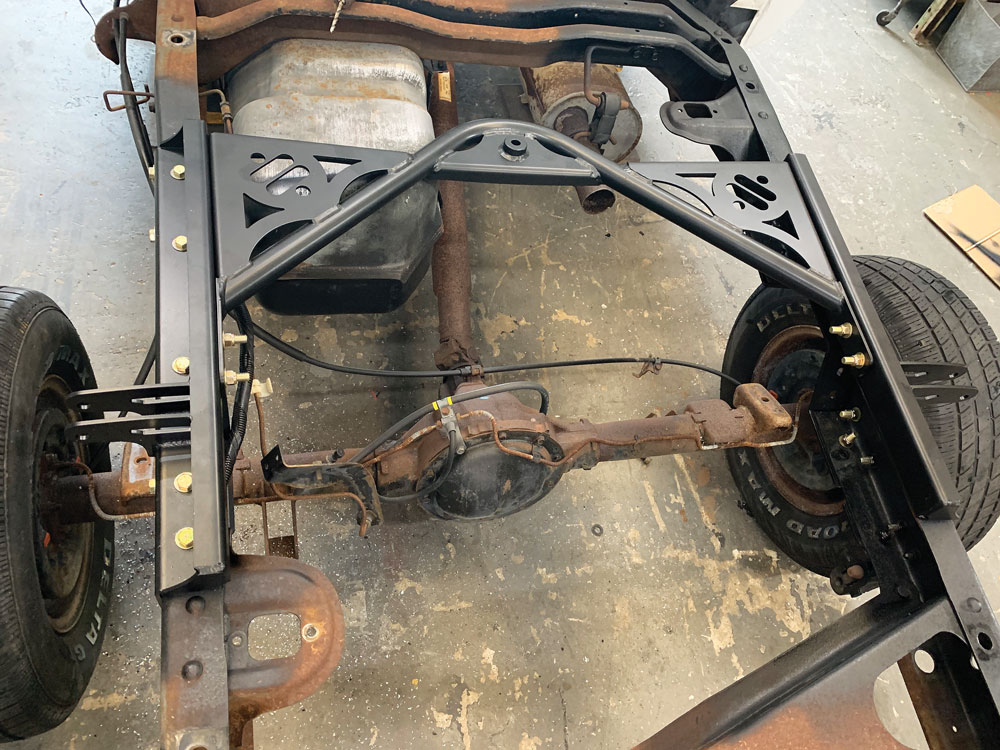
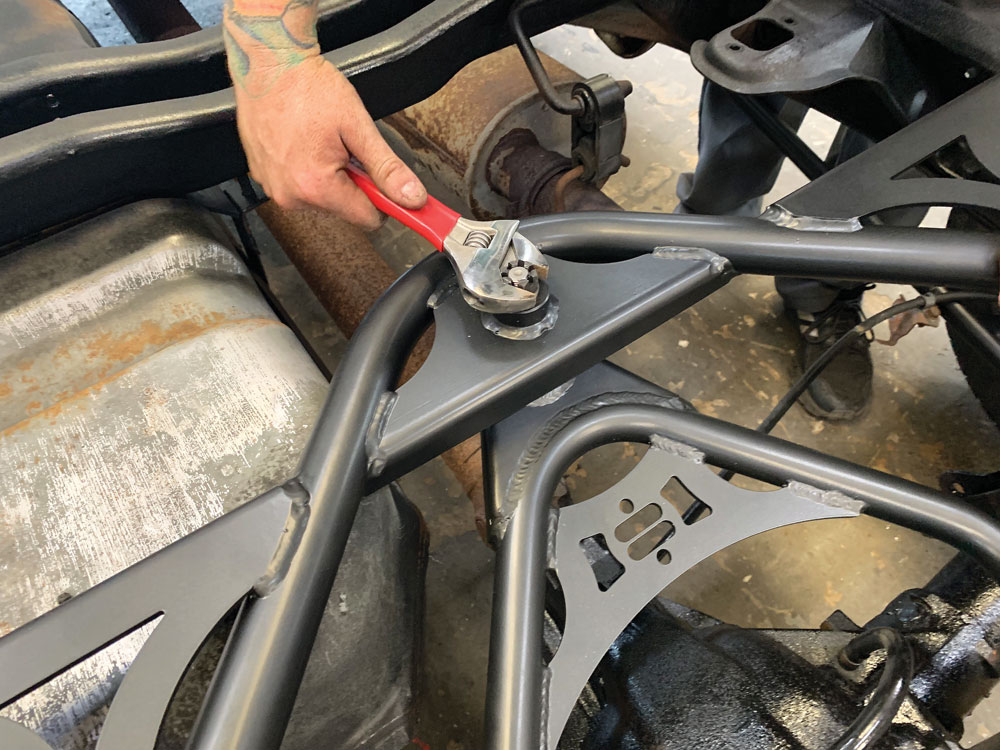
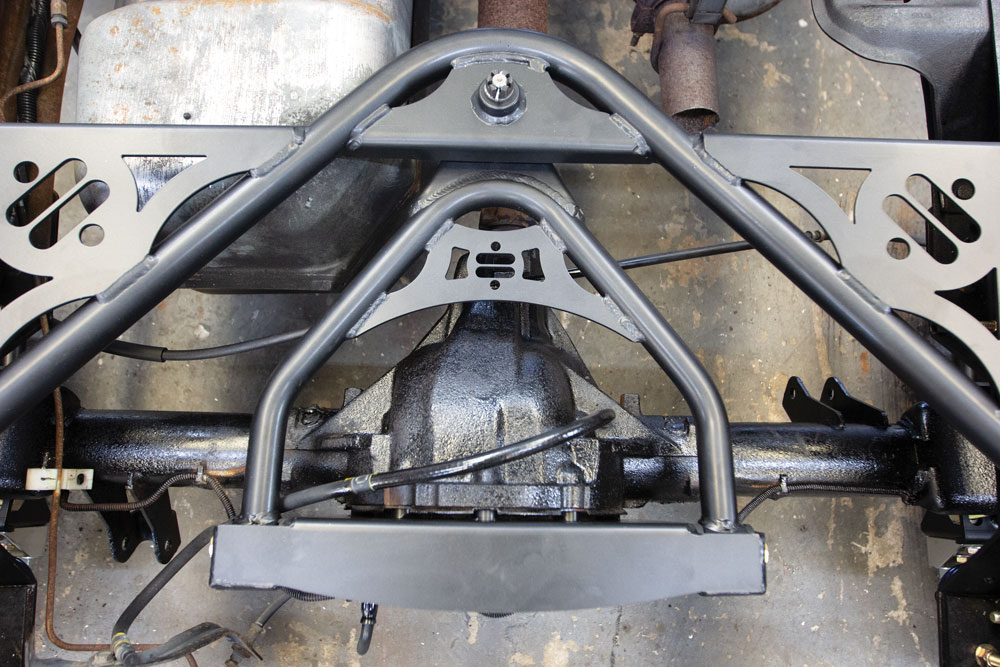
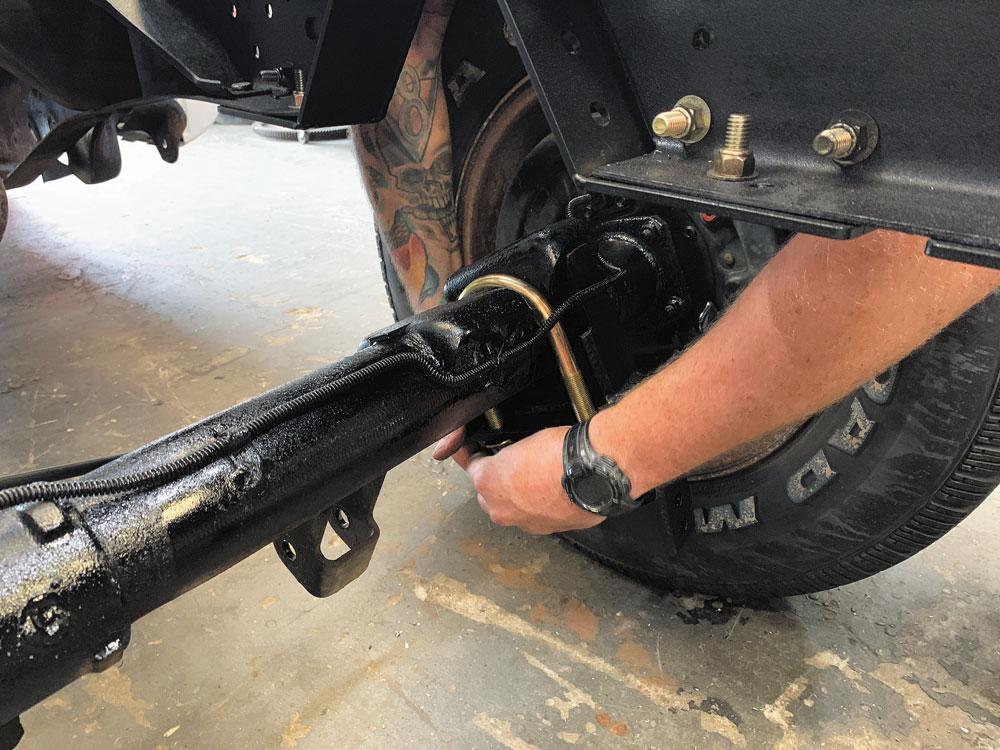
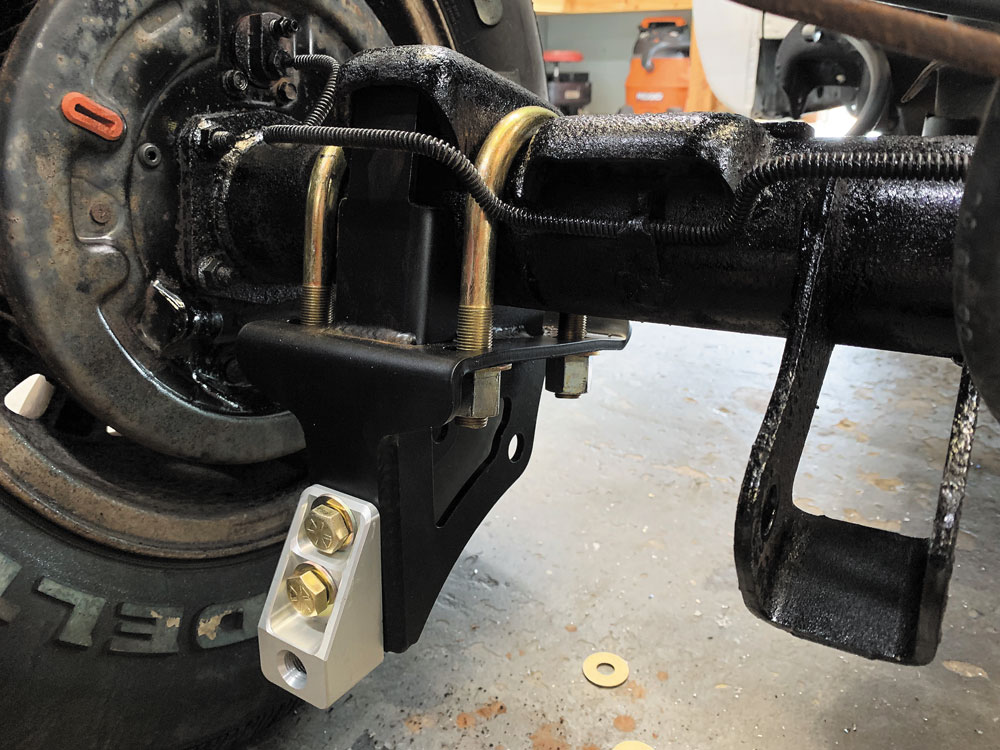
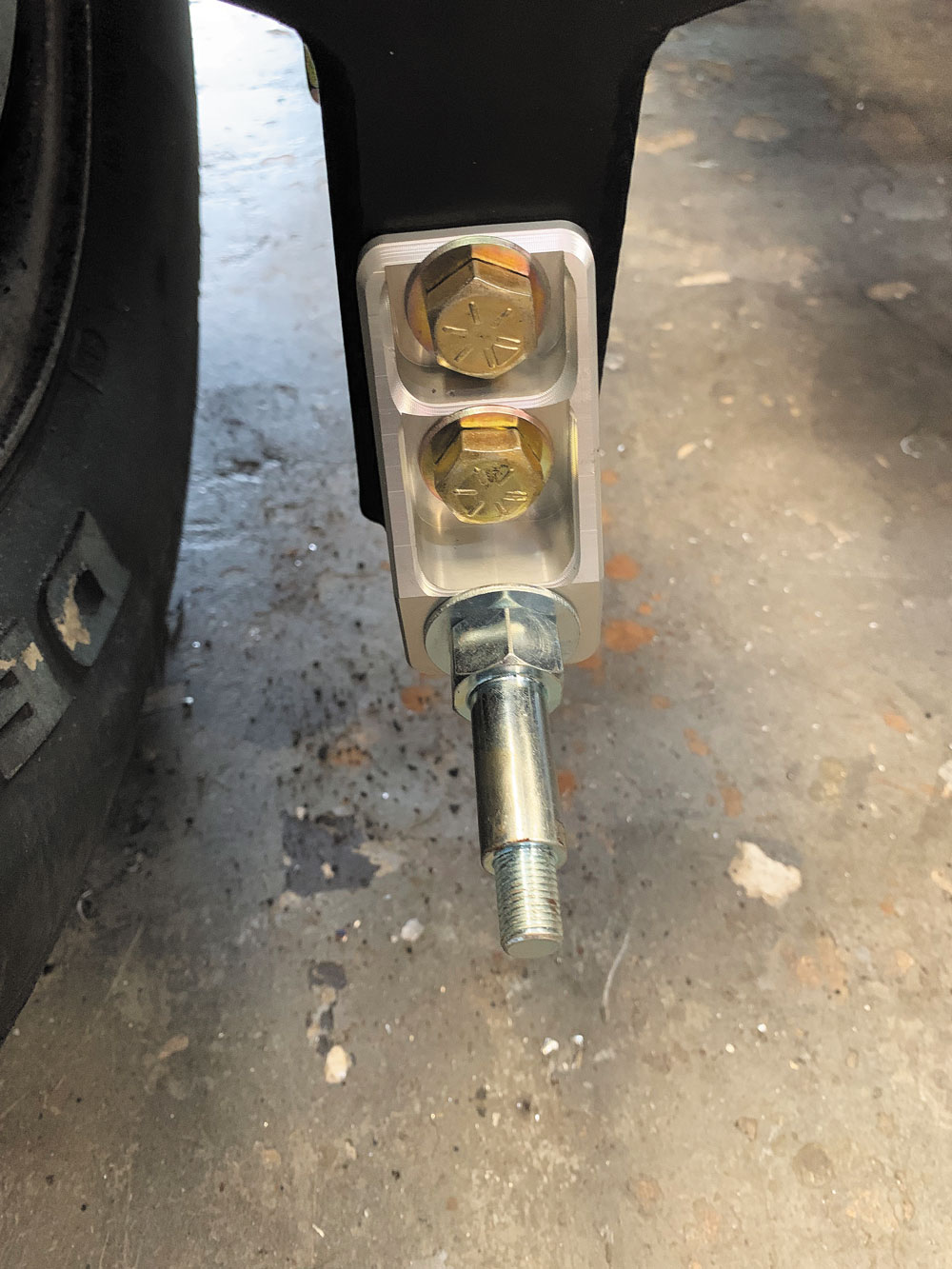
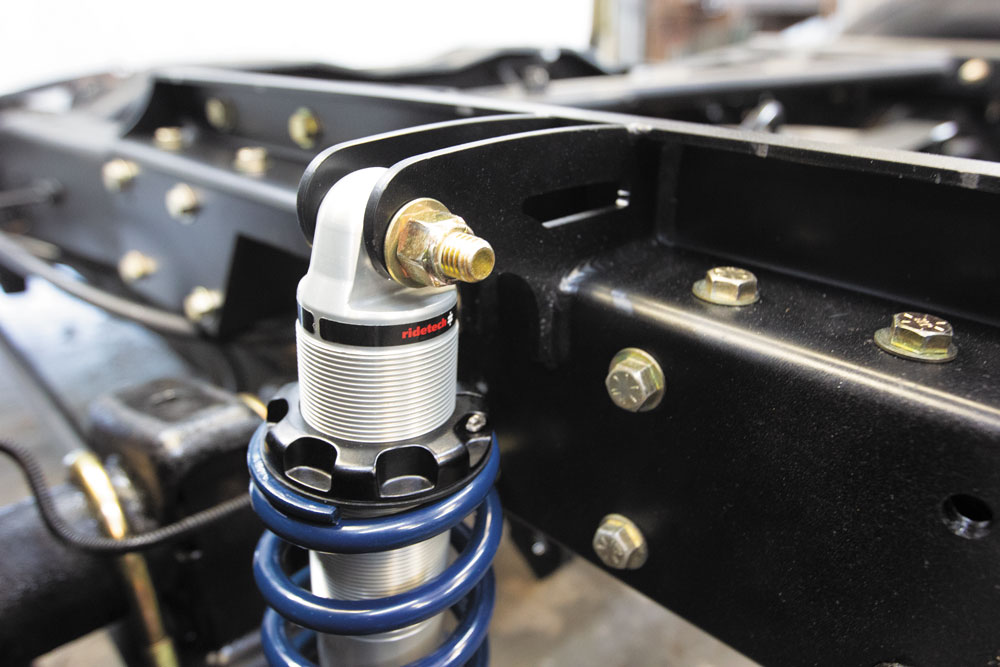
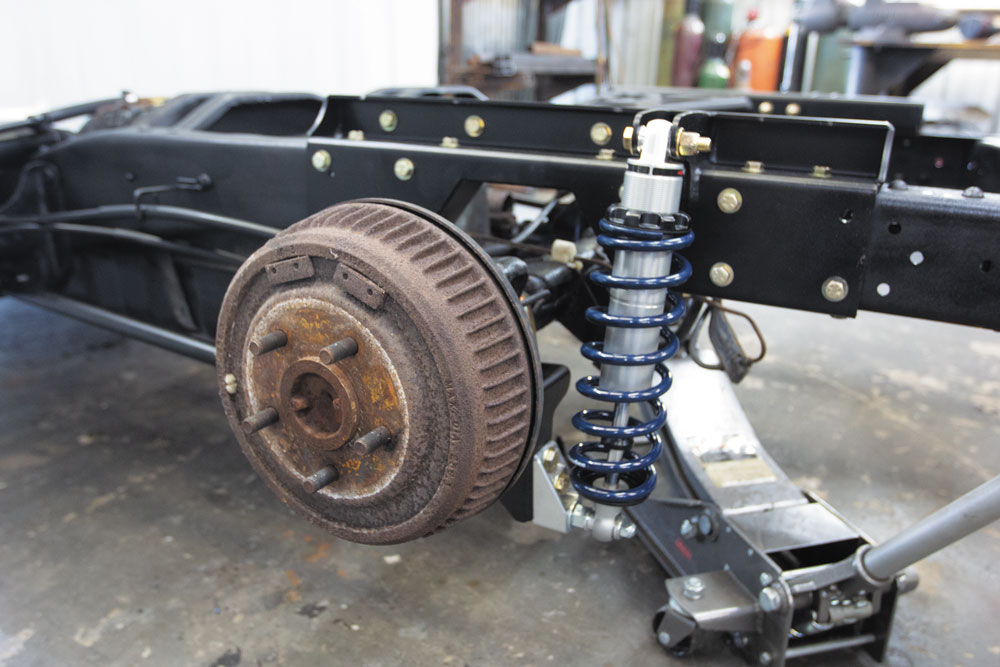
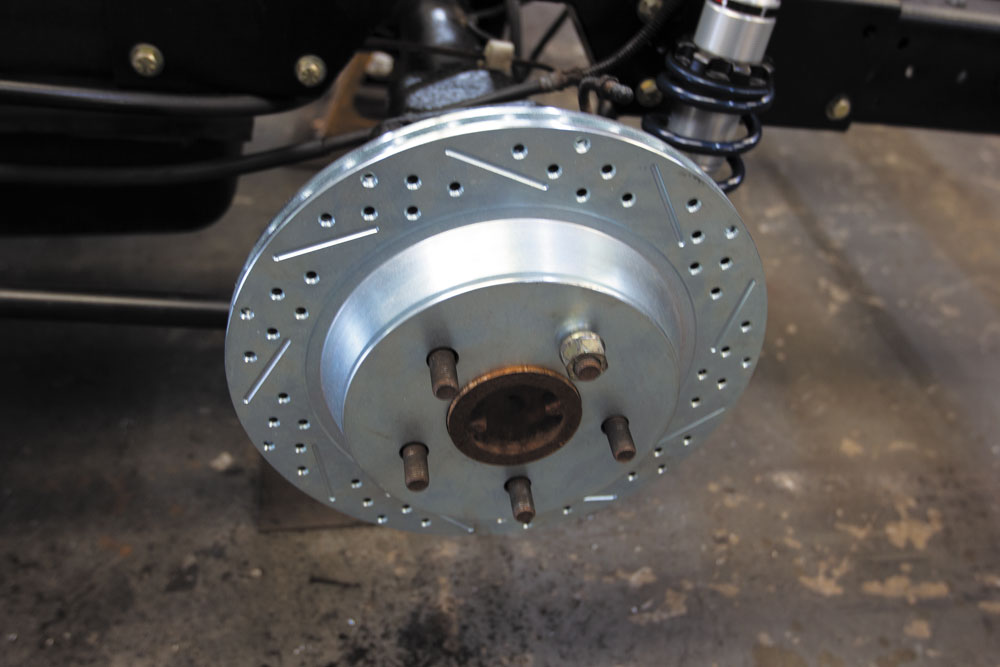
All RideTech coilovers utilize a single-tube cartridge. Known as “monotube,” the design features a significantly larger piston area, which in turn provides more responsive damping than a twin tube shock. A single adjustment knob controls the rebound curve, allowing you to fine tune your truck’s shocks to suit your driving style and specs. Also, we get our first look at this killer brake upgrade from AZ Pro Performance.
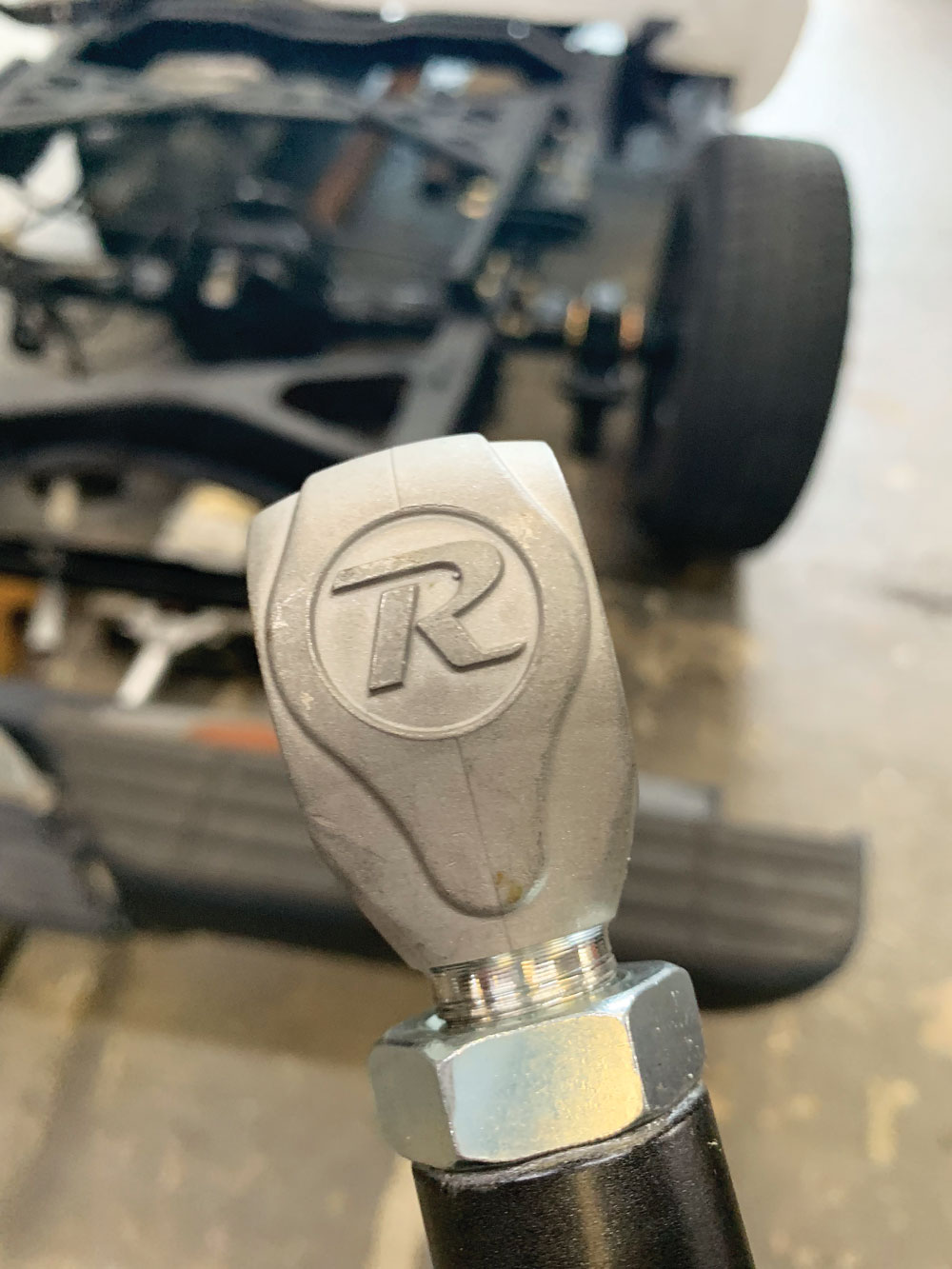
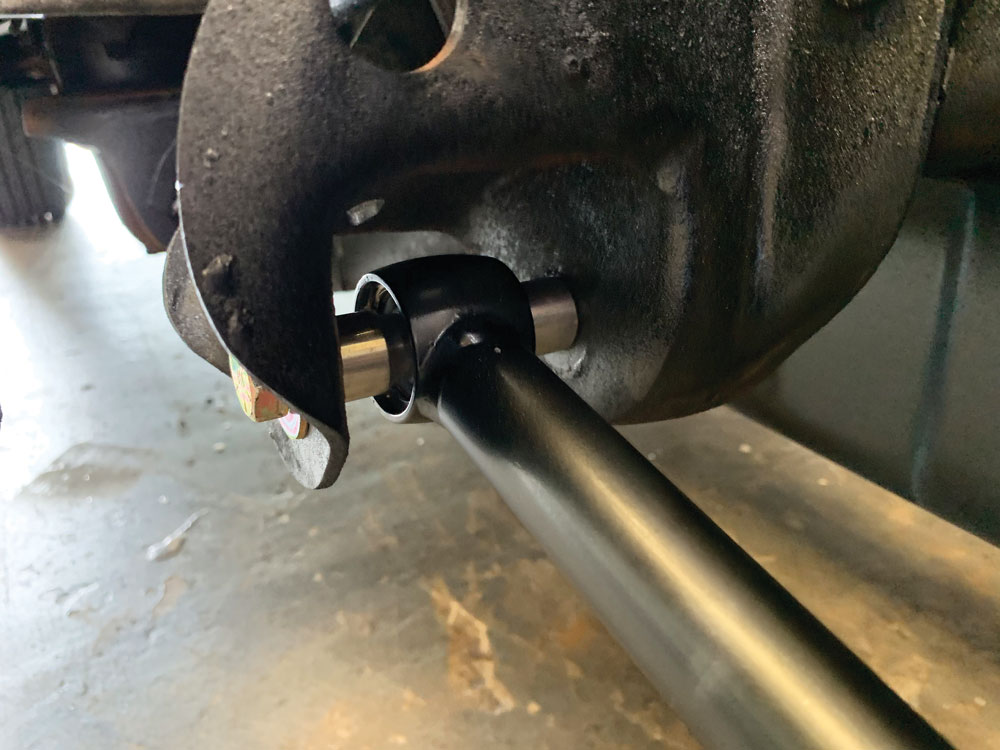
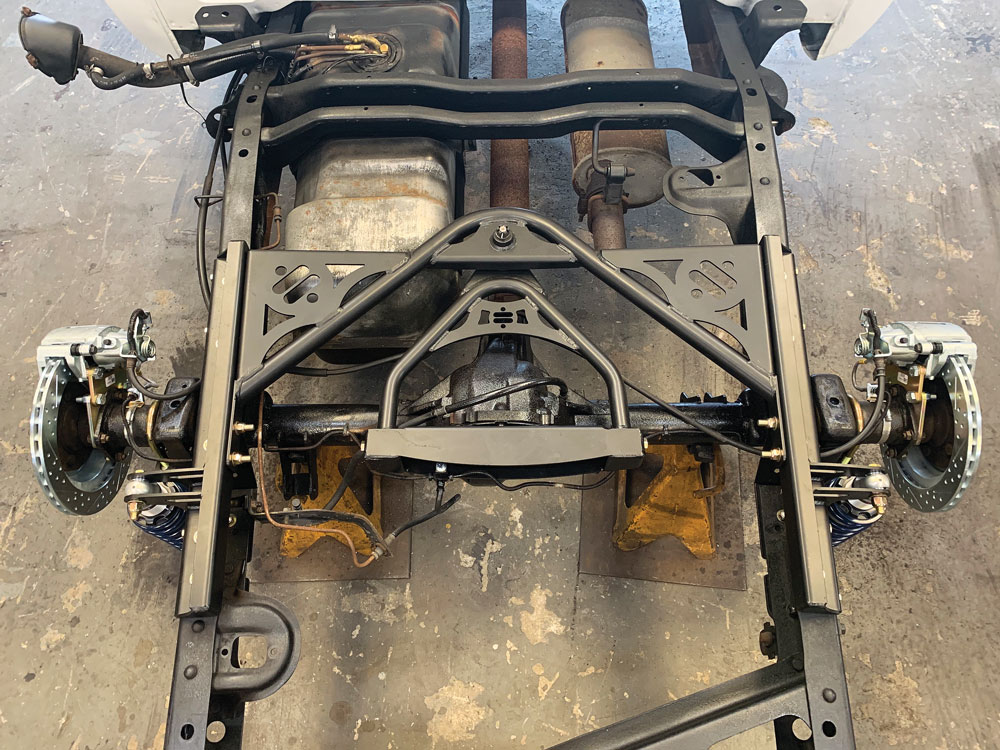
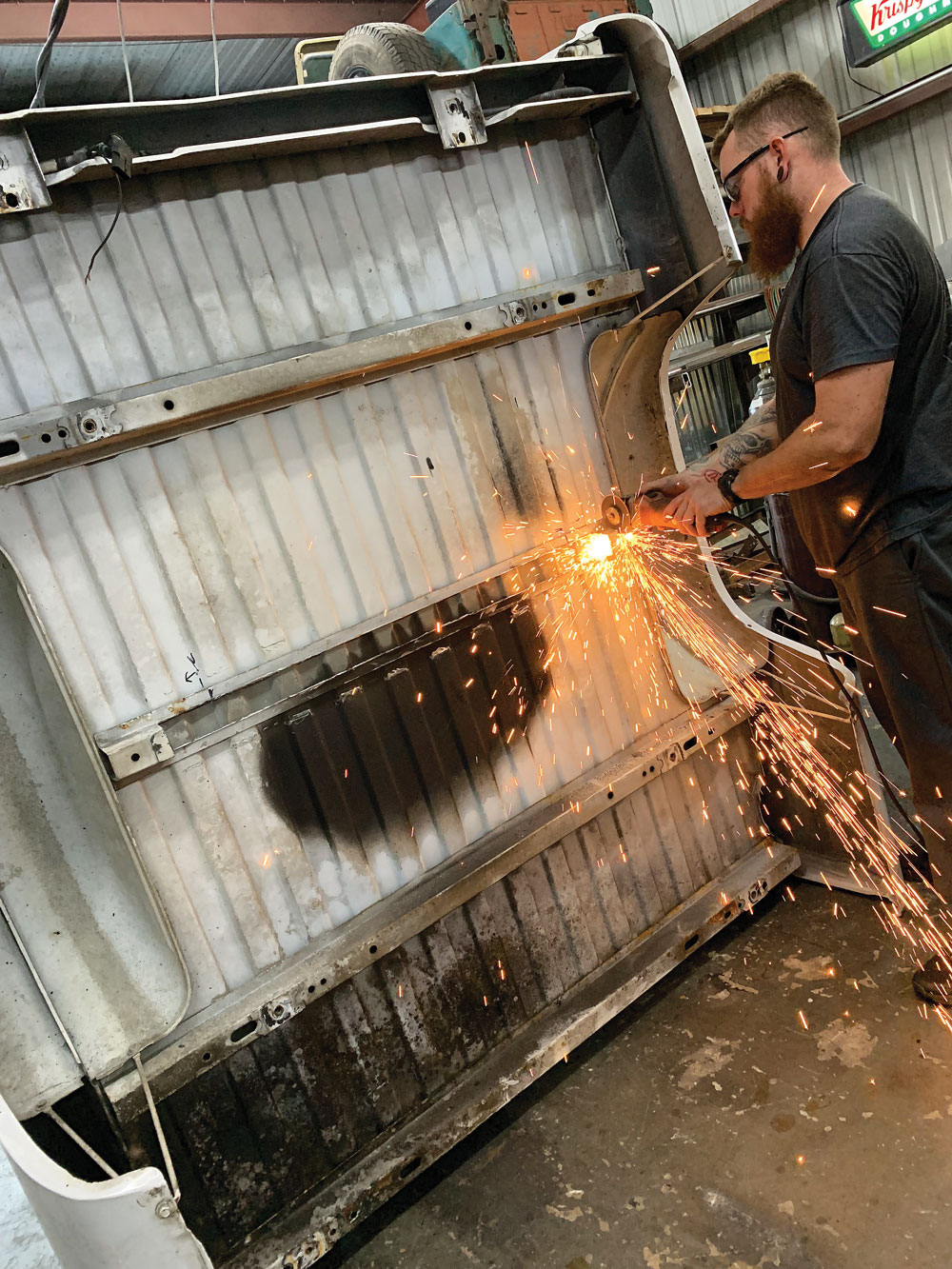
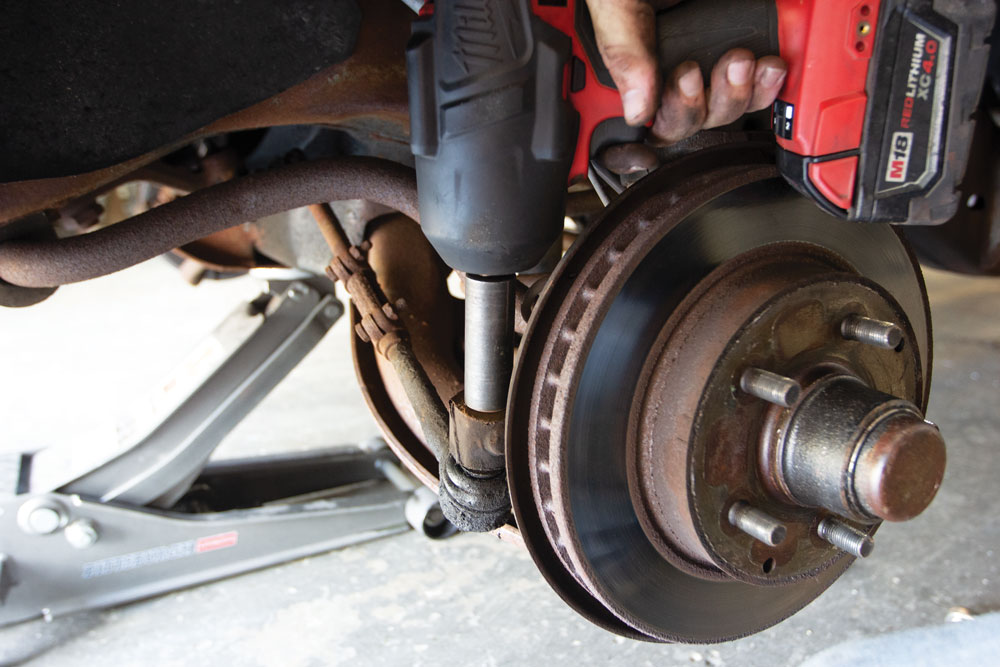
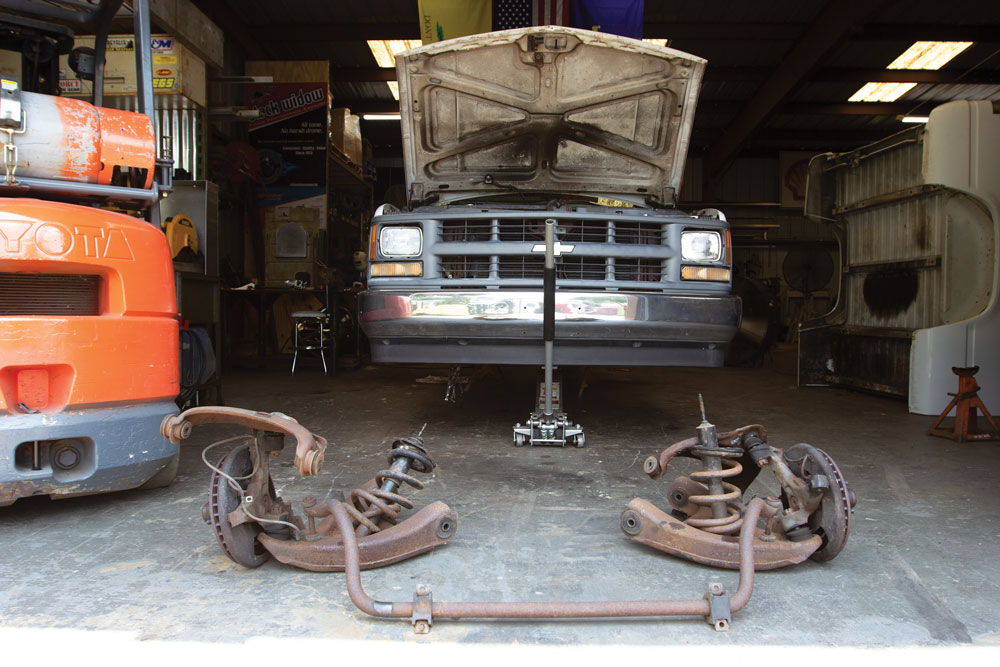
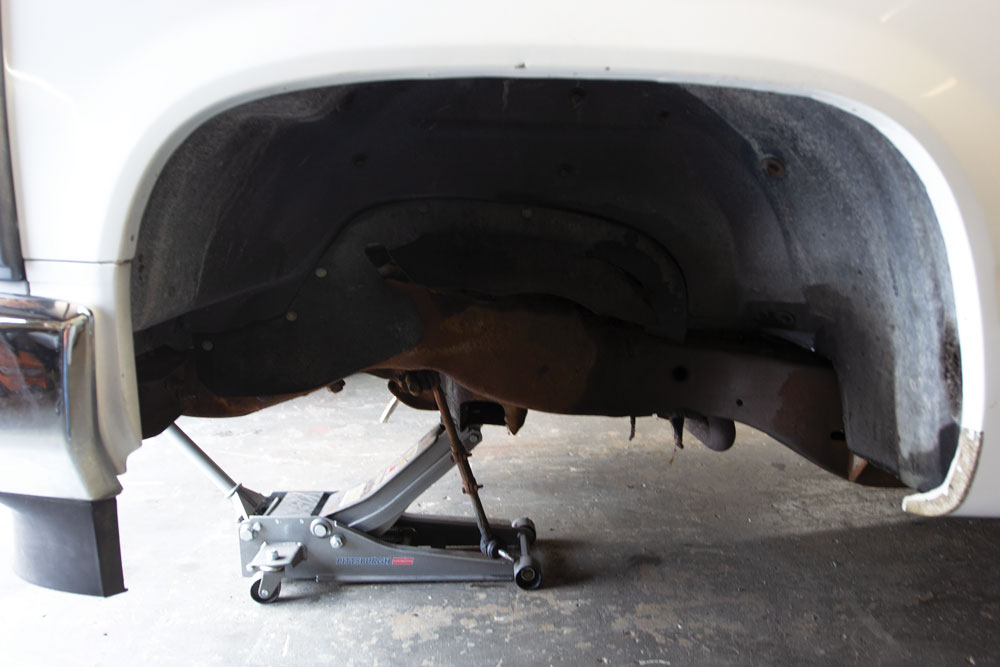
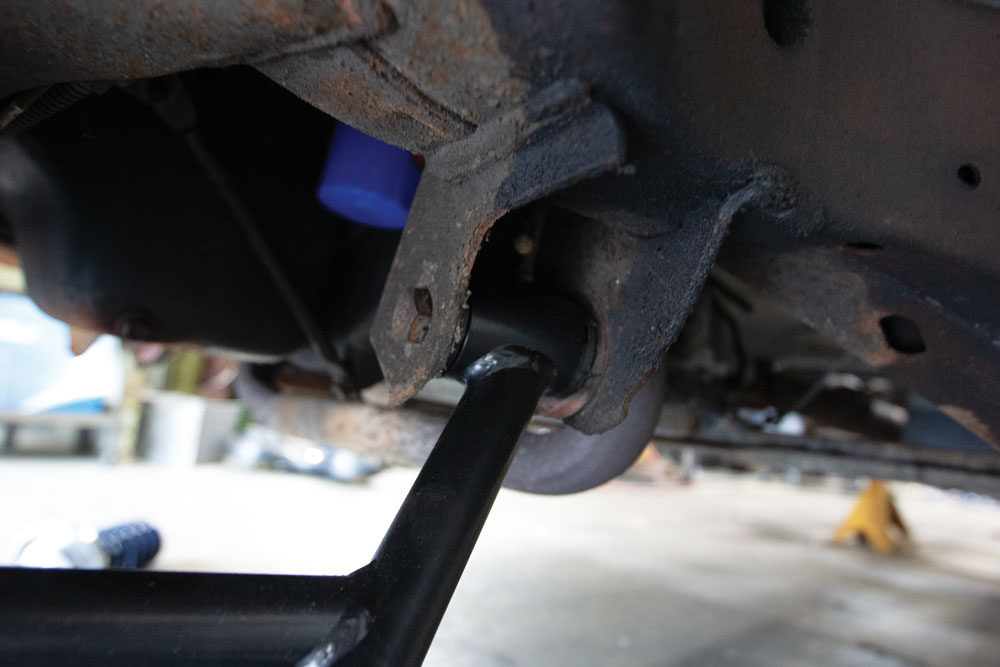
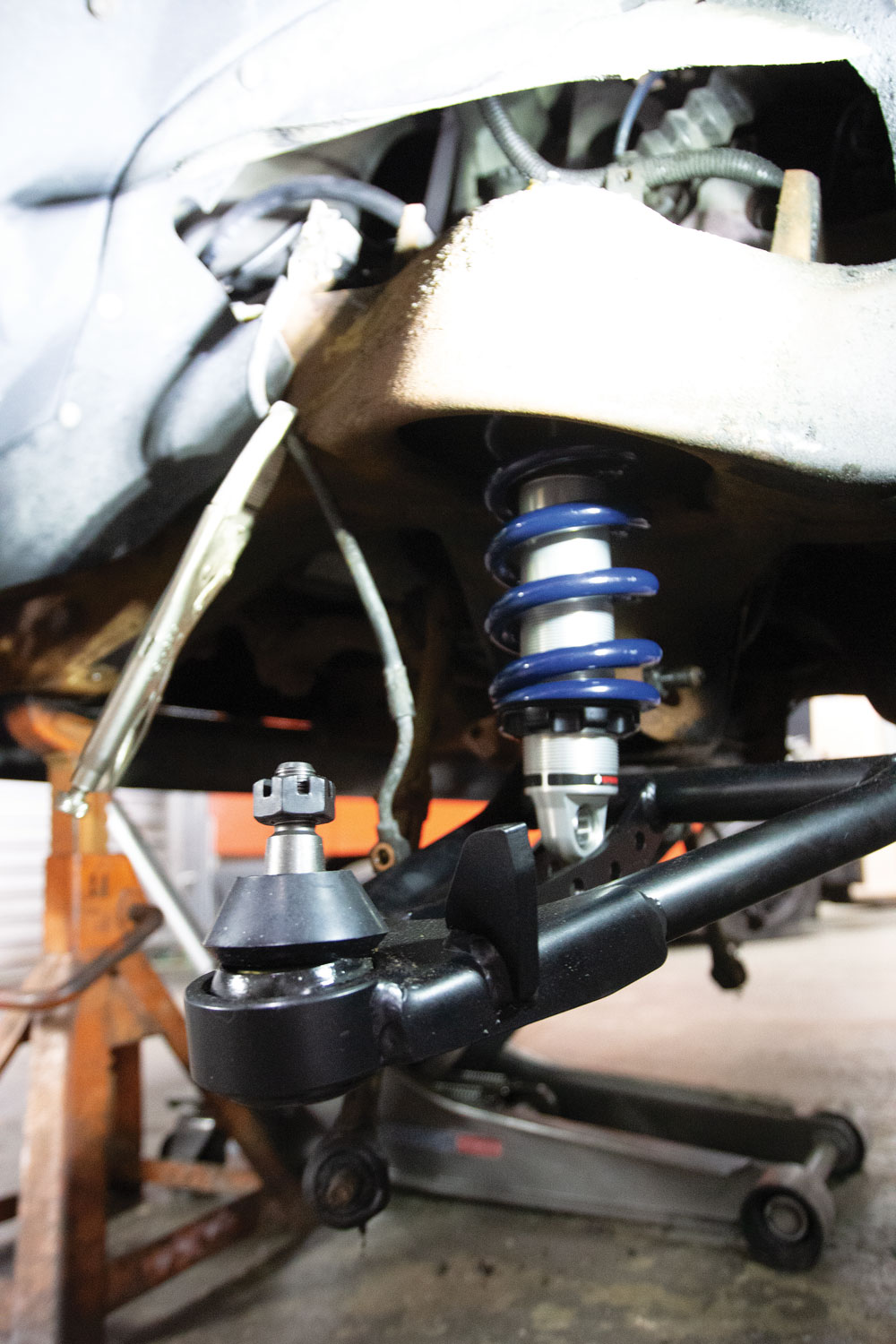
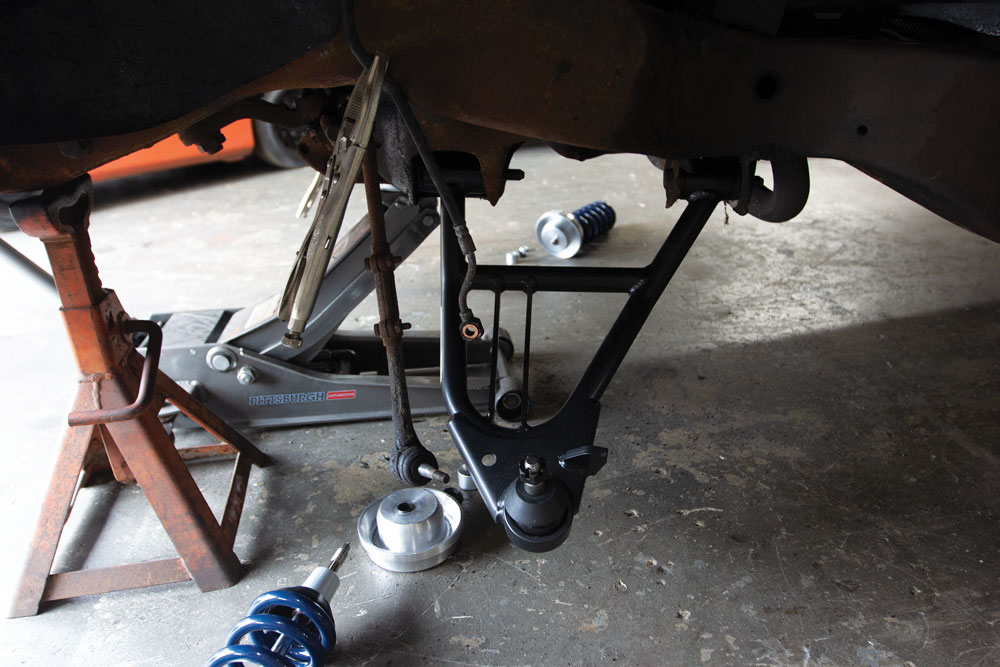
With an empty wheel well, we are ready to bolt in the new upper and lower control arms. All the factory brackets are reused and the coilovers mount in the stock shock location. Really well designed!
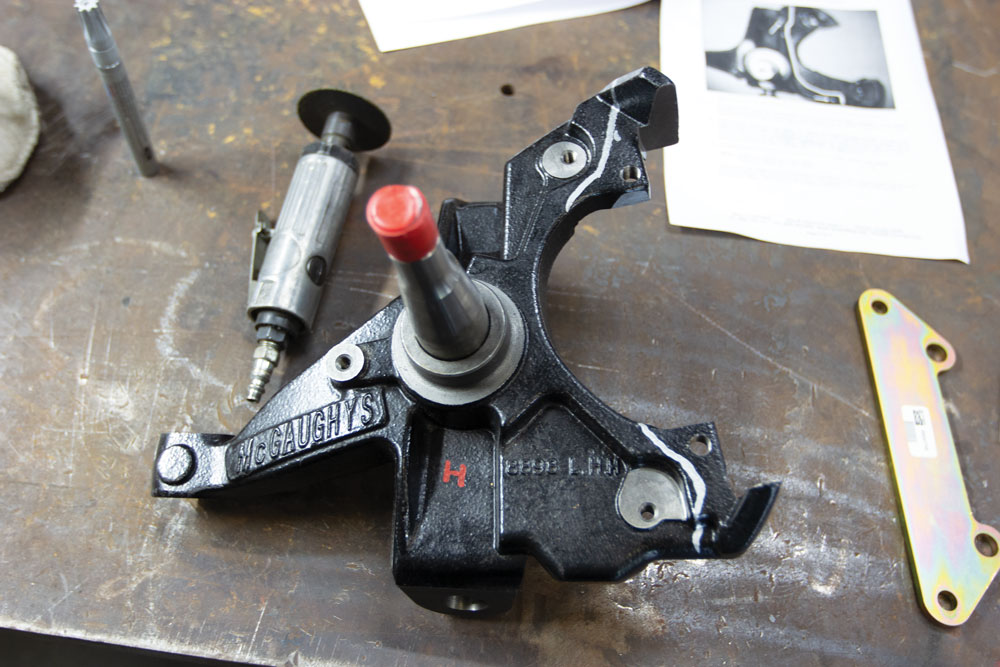
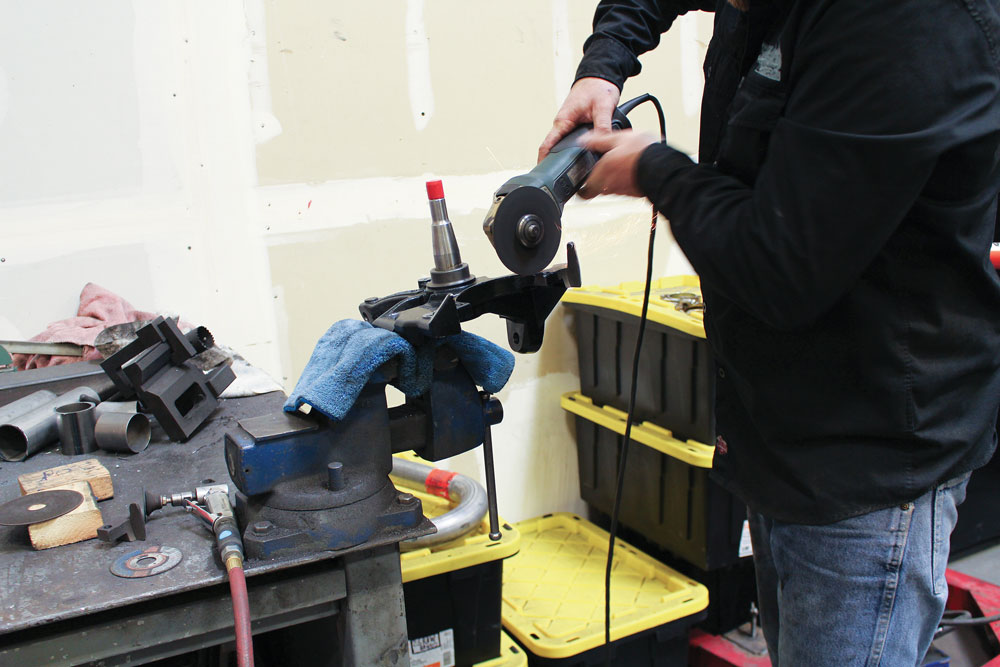
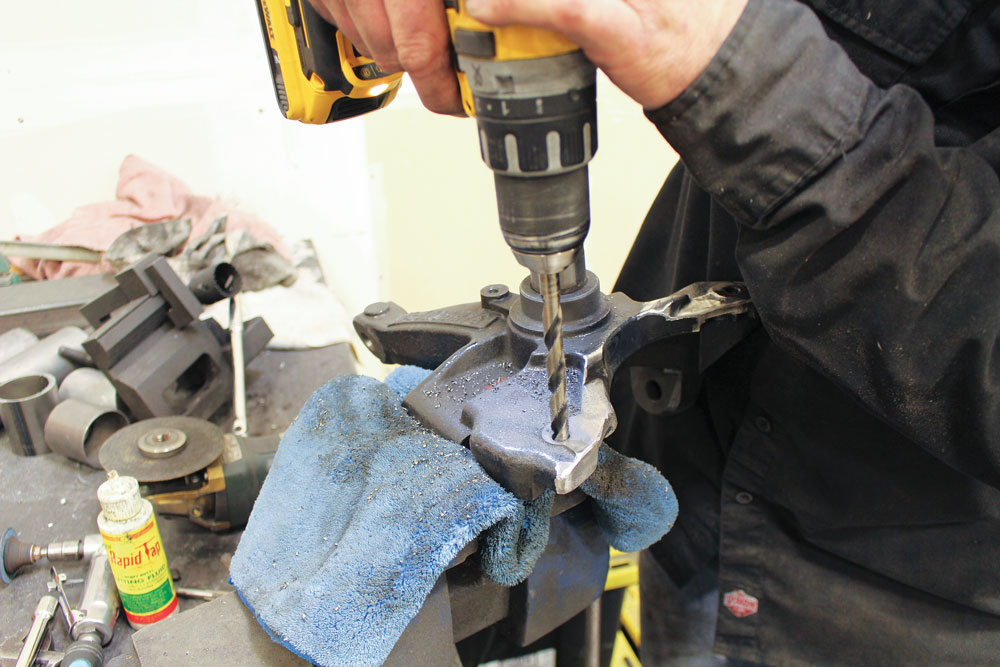
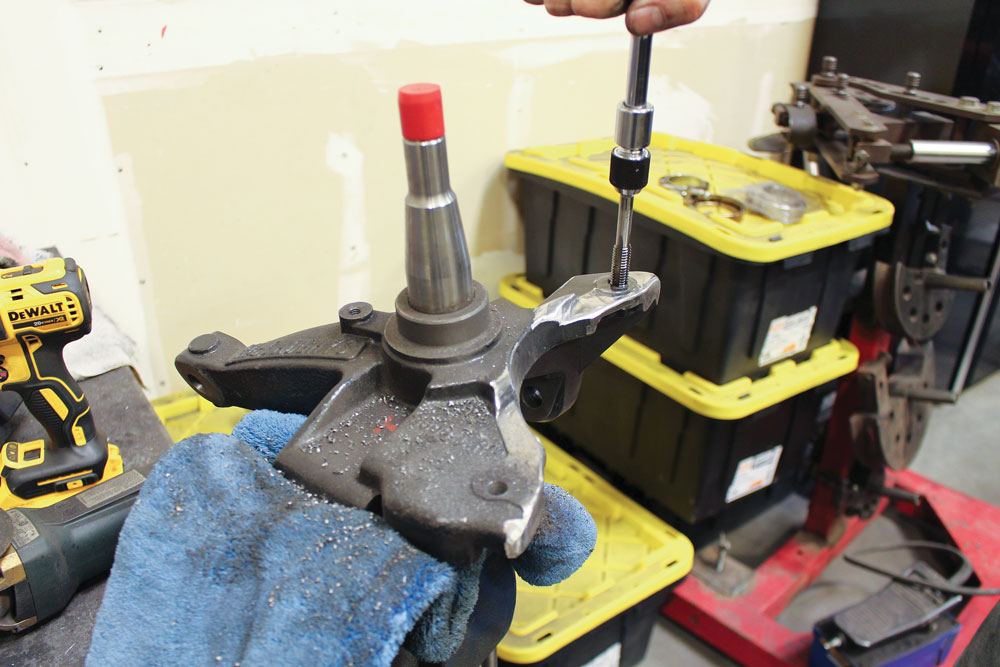
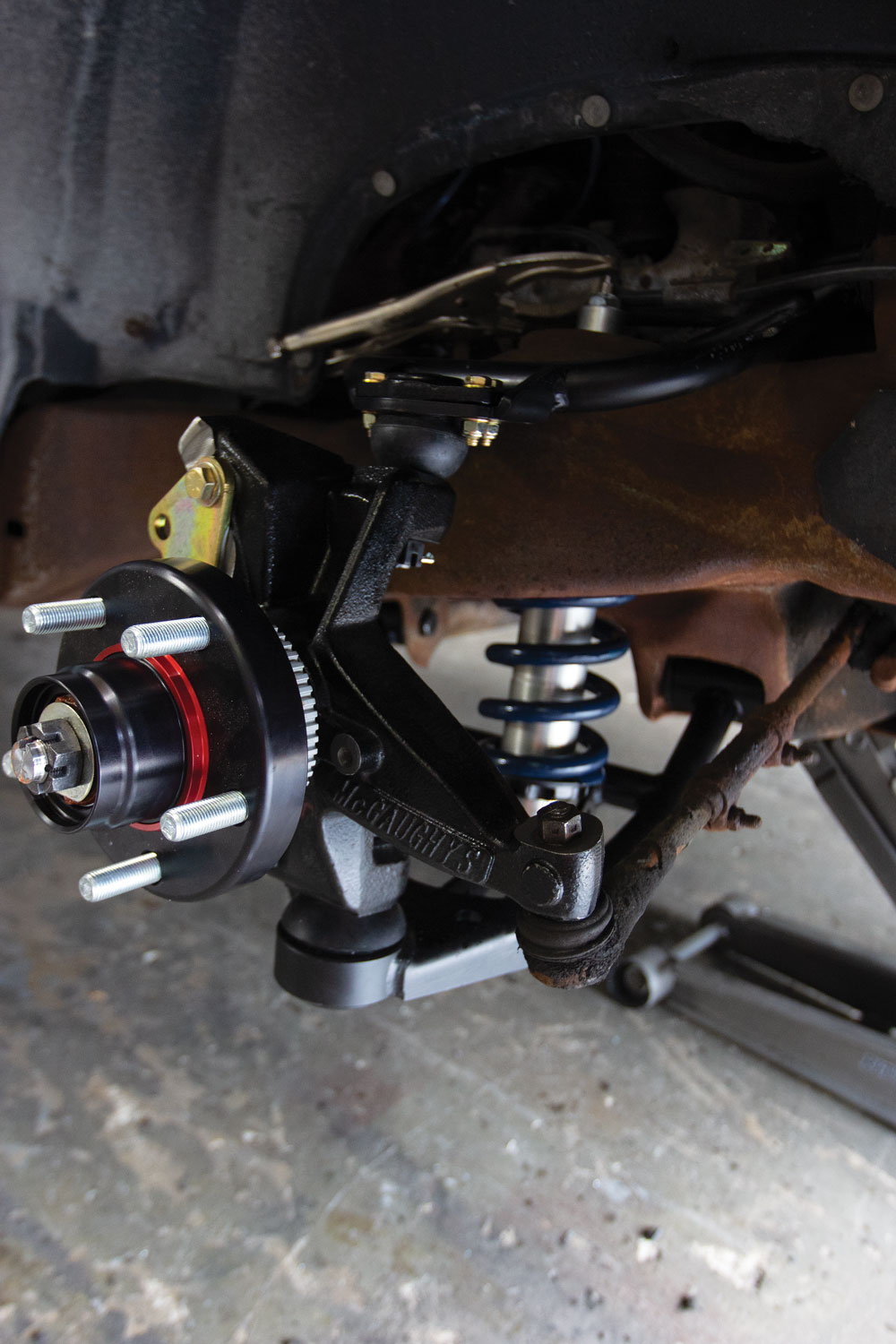
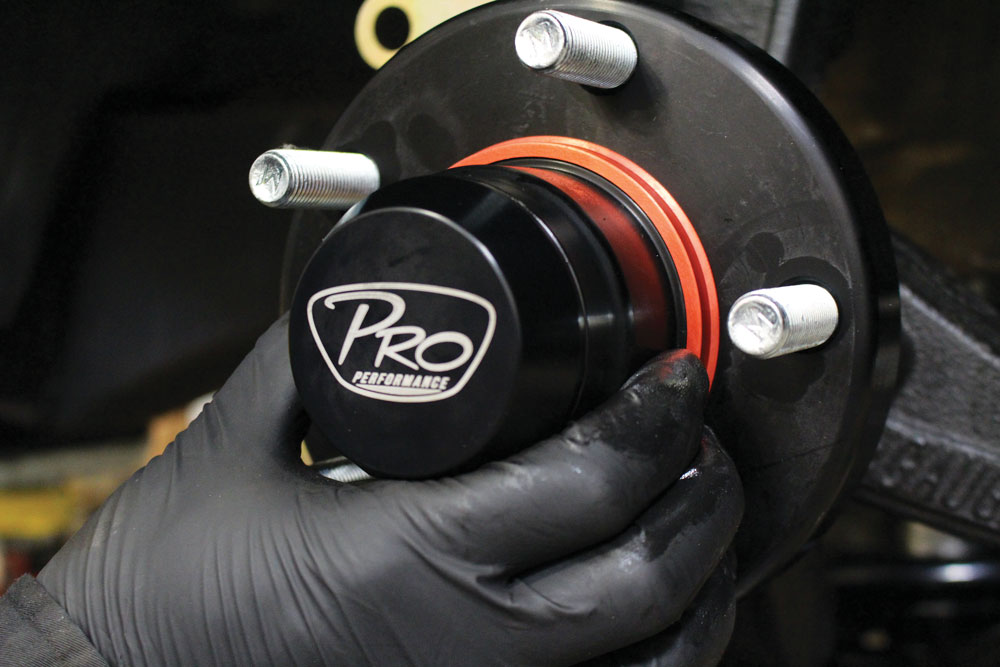
Key features of these brakes:
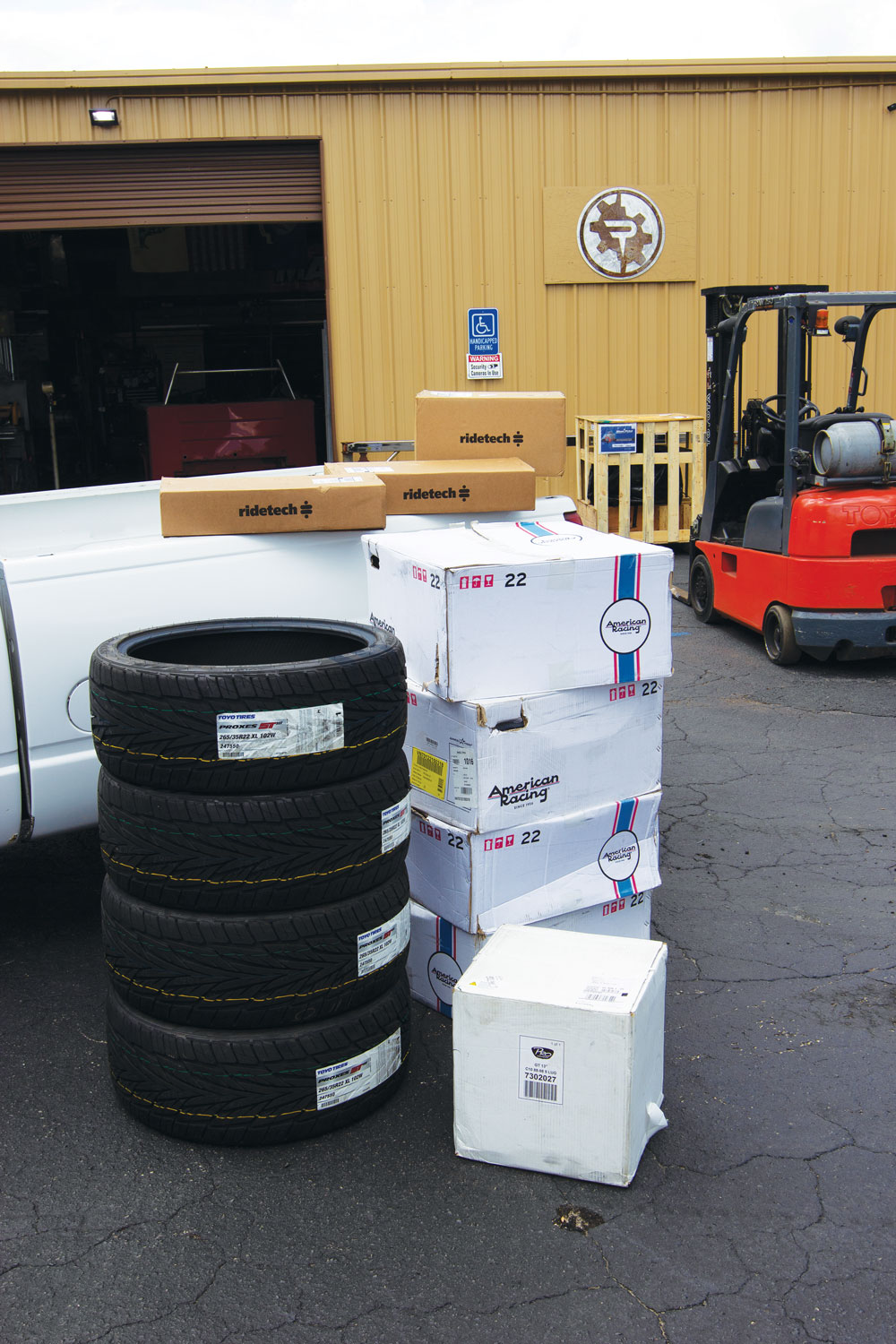
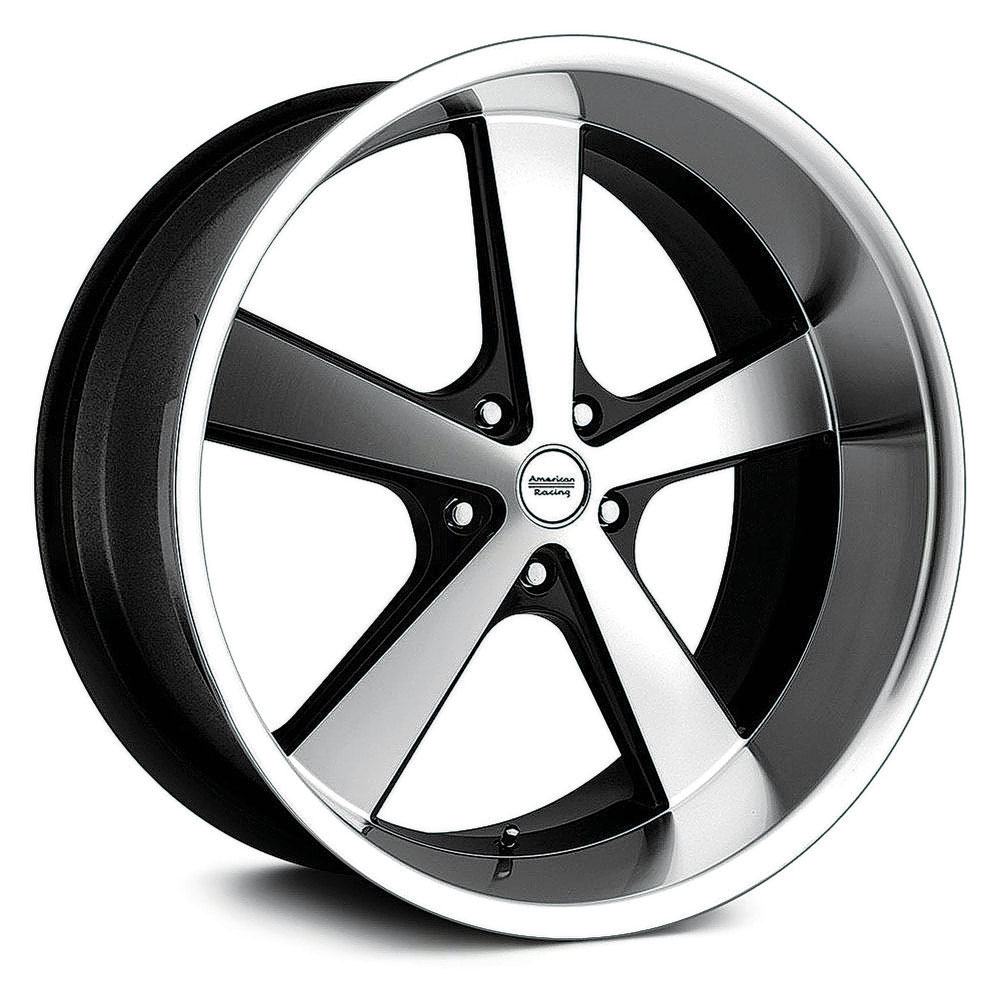
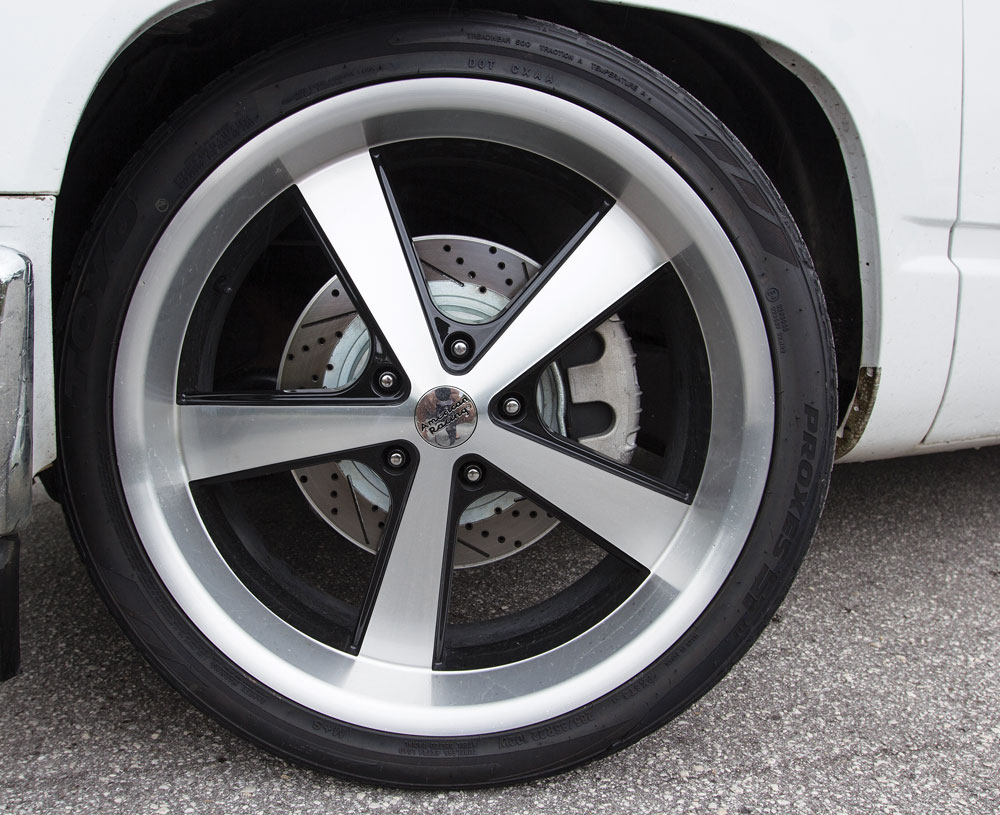
Our choice for wheels and tires are 22-inch American Racing Novas that are staggered front and back. The tires are none other than Toyo Tires ST III. The Proxes ST III is the perfect balance of dynamic looks and sport-oriented performance for trucks and SUVs. With a wider tread and a silica-based tread compound, the Proxes ST III stops up to 6 feet shorter in wet conditions while delivering superb handling, excellent all-season performance, consistent wear and a smooth, quiet ride. These tires are also backed by a 40,000-mile warranty.
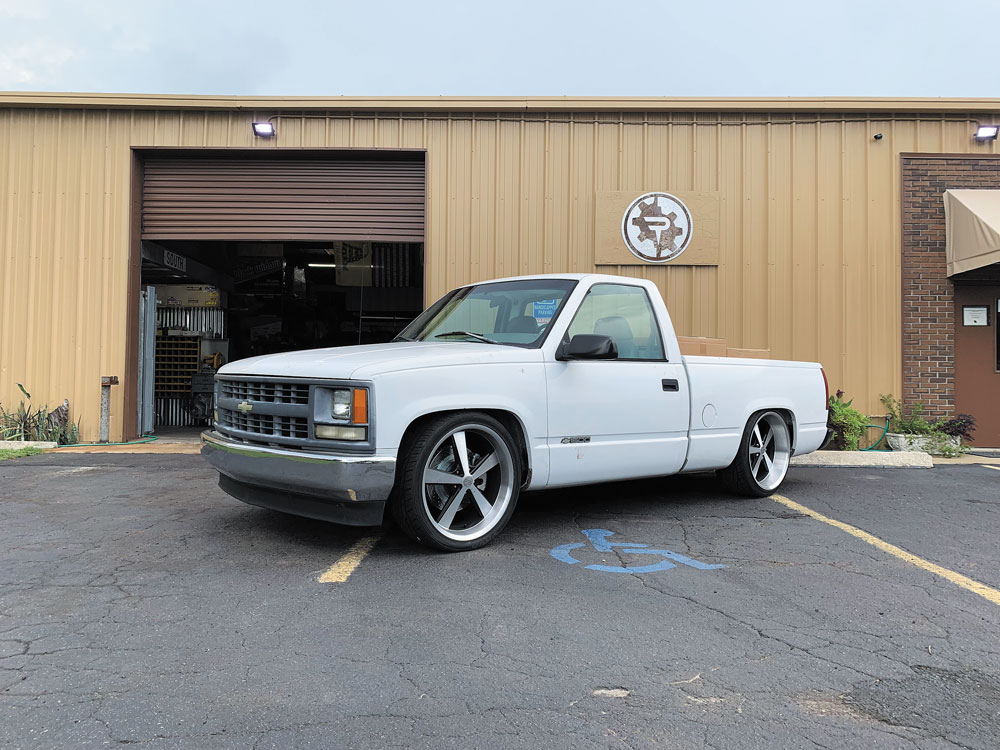
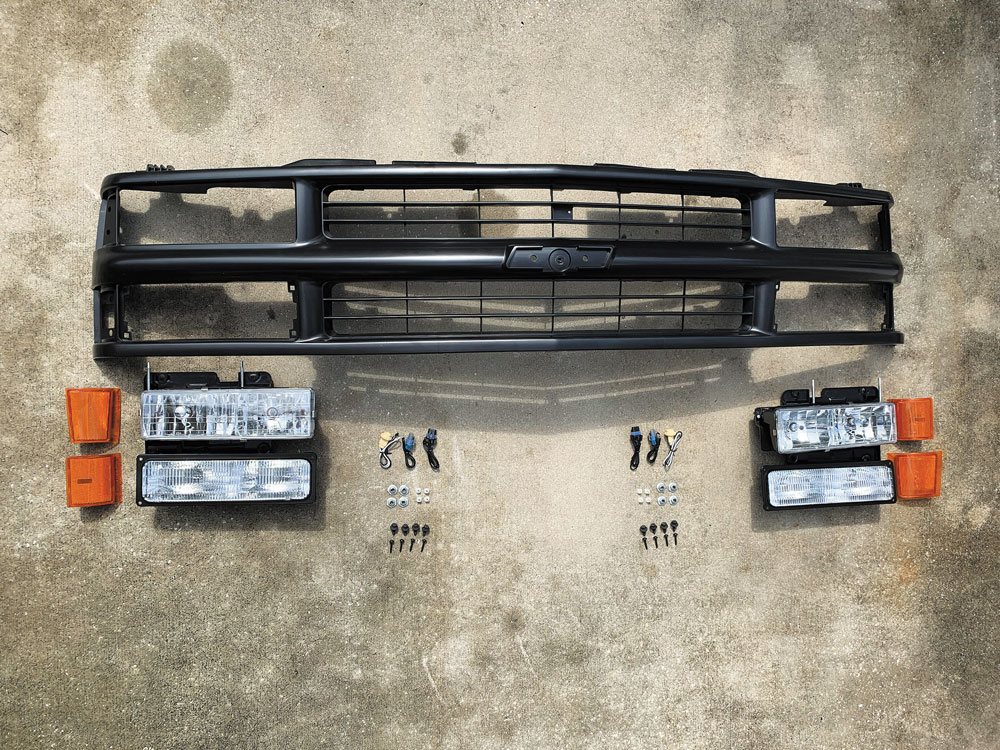
This reproduction black plastic grille is designed for models with dual composite headlamps and made to replace the original. However, it features semi-flush Bowtie emblem mounting pad for a smooth, clean look.
